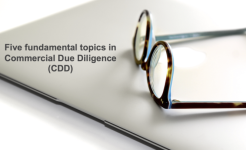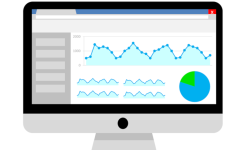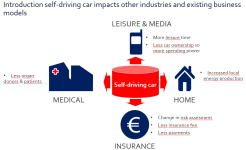-
How to Communicate Challenging Insights from your Market Research When the truth resulting from our study is positive, it can be a joy to communicate those insights. However, research efforts sometimes reveal different results than were expected or hoped for.…
-
The Market Intelligence Cycle to guide Commercial Due Diligence Pre-investment phase: conduct a Commercial DD analysis Performing Commercial Due Diligence (DD) is an indispensable part of the pre-investment phase for investors and private equity firms. It…
-
Why Market Research is Key in Business Pivoting Even if you have a successful company, there’s no guarantee your business model will remain viable for long. So what happens when the market changes, and your business needs to adapt to stay relevant? This is…
-
Discover the Advantages of Benchmarking In every industry, there are certain standards that employees and consumer come to expect from any company worth their salt. How do you know if your business is meeting those standards? The answer is benchmarking. While…
-
Uncovering the Pitfalls of Market Research: Identifying Bad Data Market research is a critical tool for businesses to gain insights into the competitive landscape and make informed strategic decisions. However, the quality of data collected is crucial for…
-
Unleashing the Power of Competitive Intelligence: How to Fine-Tune Your CI System for Maximum Impact Does your competitive intelligence system run like an outdated app you’ve been meaning to update? Do you find yourself dealing with performance issues and lag…
-
Why market intelligence has never been more important in healthcare Translating raw information into actionable intelligence through market research is critical for making the right decisions in all industries. Unfortunately, in STEM-related industries the…
-
How to create successful products and services by using conjoint analysis? Successful businesses know what their customers want (and need) and subsequently act on this. Finding out what your customers exactly want, however, can be quite challenging. Studies…
-
Market sizing in B2B markets: summary and tips Why We Measure Market Size Knowing the size of a market is a fundamental requirement for all marketing plans. The market size is a measure of the potential available to a company and it is the starting point for…
-
Product Testing: A Simple, yet Effective Approach to Marketing Research I attended a marketing research conference this past spring that combined academics, students, and practitioners for a one-day event. Over the course of the day, I had the pleasure of…
-
Launched a new product? This will help you measure its success According to Harvard Business School, of the approximately 30,000 new products launched each year, about 95% fail. Of course, the product failure rate varies from one industry to another—for…
-
Designing the Ideal Competitive Intelligence Department What does the compete department at your company look like? Is competitive intelligence the responsibility of one person? Two people? A whole team? Odds are, your CI program is just a fraction of one…
-
A brief guide for those who consider a career in market intelligence Market research and insights careers are having a moment thanks to the proliferation of data across the business world. Here’s how to become a part of the community. Thanks to the…
-
5 Skills a competitive intelligence expert should possess The skills and traits of a competitive intelligence expert all have one thing in common: connection. Connecting the dots between people, ideas, and execution. In baseball, a five-tool player is someone…
-
Hopping your way to successful shopper research Research can be a little bit like the game of hopscotch. You take the first hop, then the second (maybe the third at the same time), then the next, then the next, and so on. All the while, you’re gaining…
-
Brand research: segmenting consumers who aren't using your brand Knowledge of your brand's users is only part of the research equation. You need to understand who currently isn't choosing your brand, who never has and never would, and who used to choose your…
-
The Latest Insights From Sustainability Related Market Research Environmental sustainability is a major trend impacting a broad range of industries, and many different market research publishers have released new reports covering this topic from every angle.…
-
The four customer journey archetypes Most marketing experts agree that it’s not enough to give customers a satisfying initial experience with a product. Instead, product managers must offer them a compelling series of experiences—a customer journey—to keep…
-
Making competitive enablement your expertise You’ve met with your stakeholders You’ve prioritized your competitors. You’ve built out a content framework, a battlecard template, an executive dashboard. You’ve laid the foundation, and you’re ready to rock and…
-
Before jumping to conclusions, ask 'why'? An account executive on your sales team, Jen, is chatting with a prospect. The conversation is going well. The prospect doesn’t seem to be evaluating any other vendors. And then they say this: “Talk to me about your…
-
Selection bias: what is it and how to keep it out of your market research? What Is Selection Bias? Selection bias occurs when research participants are not randomly selected. This leads to errors in research results, which negatively impacts the validity of…
-
Social intelligence: social media data as a means for market intelligence To be successful as researchers, we need to know our customers. We seek to identify our customers’ needs, desires, and opinions about our products, brands, and competitors. In doing so,…
-
Measuring competitive confidence: what to ask? Running a competitive confidence survey will soon be a matter of course for competitive enablement programs. Measuring sales confidence levels in your compete program and against your competitors will give you…
-
The benefits of continuous market monitoring Market intelligence studies are often event-driven and have a clear begin and end. Usually, there is a decision that needs to be substantiated by specific market insights. As a consequence, managers start running…
-
Five fundamental topics in Commercial Due Diligence Commercial Due Diligence (CDD) is a vital aspect of the pre-investment process for private equity firms and investors. CDD is typically conducted before buying negotiations begin, in order to allow the…
-
3 Steps to ensure your competitive intel is put to good use by sales reps J.K. Rowling didn’t write seven Harry Potter books for no one to read them. Just like you didn’t put in the time to research and source competitive intel for no one to use it. There’s…
-
Optimize your survey design through iterations In a market starved for survey participants, designing surveys that encourage participation is key. This article describes how to optimize your survey during fieldwork by making small, incremental iterations…
-
Supporting Product Development with Competitive Intelligence It's no secret that competitive research is a challenge for product teams who already have more than enough to do every day. But in order to develop successful products, it's important to keep track…
-
The impact of inflation across several industries and regions The COVID-19 pandemic greatly influenced consumer behavior for the last two years, but in 2022, the central concern will increasingly be the cost of living, according to research cited in a recent…
-
The case for a tiered approach when tracking competitors I don’t think I’ve ever walked up a basement staircase. If I’m feeling courageous, my ascension might look something like a casual jog. Most of the time, though, I’m climbing that thing as fast as I…
-
The key to monitoring loyalty program success In February 2020, Panera Bread announced the Unlimited Sip Club and rocked the coffee world. For just $8.99 a month, members could get unlimited refills of their favorite coffee or hot tea at any Panera location.…
-
Tracking Brand Equity We can think of Brand Equity as the accumulated reputation and goodwill of the brand or brands owned by a company. This is a greatly simplified definition of brand equity, but it will suffice for now. All other factors being equal, Brand…
-
7 strategies to discover new market opportunities From supply chain bottlenecks to inflationary pressures, businesses across industries continue to grapple with a world defined by relentless change. In this unstable market landscape, business-as-usual…
-
What to Expect in Customer Experience and Market Research this Year? The Customer Experience (CX) discipline, including market research, is continuously changing, and being enhanced as more organizations understand how critical CX is to future growth. And…
-
Meat substitute market | Europe The market for meat substitutes is booming. The European market is currently valued at €2.8 bn. (€6,3 per capita per year: indicating growth potential) and expected to grow towards €5.3 bn. (€11,9 per capita per year) in 2026,…
-
Questionnaire design: garbage in, garbage out One of the most useful ways to collect data when conducting market research is via the use of HUMINT (Human Intelligence). Data can be collected via in-depth qualitative interviews or large scale quantitative…
-
Market research via online survey: Should you include a progress bar? Progress bars have been used as components of surveys for a long time. Are they still relevant? Do they help or hinder your participants' survey experience? In the MRxPros Google Group,…
-
Competitive pricing analysis: getting familiar with competitors' pricing strategies What should be the right price for your product or service? Are you optimally pricing your offerings or leaving money on the table? Should you deploy differential pricing,…
-
6 myths about market research to stay away from Introduction In order for a company's products and services to be not just well-accepted but welcomed by clients and customers, a thorough understanding of the company’s markets, competitors and customers needs…
-
Market development: how to grow your business internationally? An essential and often recurring topic for many businesses is growth and the ways to successfully achieve this. It is a fundamental part of a company’s corporate strategy, which defines the…
-
The key developments expected in the beverage industry in 2022 Beverage sales rose during the COVID-19 pandemic, but it will be difficult for beverage companies to replicate the record-setting gains of 2020. The beverage industry faces a variety of challenges…
-
Using competitive intelligence to determine strategy Introduction Gathering competitive intelligence (CI) usually has one foundational goal, and that is to enable an organization to make better business strategies. The importance of competitive intelligence…
-
Blind spots: question is not how to avoid them but how to deal with them Scope of Market Intelligence depends on ‘intended use’ Every proper market research starts with determining intended use and accordingly scope. Adequate scoping (which is a key success…
-
Using social media data to analyze market trends Market trend analysis is an indispensable tool for companies these days. Social media gives analysts access to data that might otherwise be tough to collect. Rapidly changing business conditions require deep…
-
Competitive Intelligence: the benefits of understanding your playing field “It is more important to out-think your enemy than to outfight him” – Sun Tzu The quote above is from Sun Tzu, who lived in ancient China from 544 BC to 496 BC. Although Sun Tzu’s ‘The…
-
Product out of stock? Gain insights from it! As I was at a home improvement store this weekend looking for some boxes for packing, I had that sinking feeling we’ve all probably experienced lately. In my case, that feeling meant ‘no boxes’– at least, not the…
-
Market sizing in B2B markets: relevance and challenges Markets come in all sorts of shapes and different dimensions to segment, and there are many variables to take into account to successfully operate within a market. One important aspect you should be aware…
-
5 types of market data to collect when expanding your business When planning to expand a business to another area globally or locally, you need a lot of information to make this move as secure and smart as possible. There is no point in making a significant…
-
Why market research should always be taken into account when making corporate decisions Not long ago, a mailer from a major industry trade organization fluttered into our box, advertising a marketing research conference entitled “Earning a Place at the…
-
Why AI requires market reseachers to generate actionable insights Artificial intelligence algorithms are designed to make decisions, often using real-time data. They are unlike passive machines that are capable only of mechanical or predetermined responses.…
-
Competitive intelligence: an overview of competitive pricing strategies At all business levels—and especially at the enterprise level—product pricing can be a challenging yet vital activity. How much should your company’s products cost? Should you go with…
-
Overcoming data challenges in the financial services sector Importance of the financial services sector Financial services industry plays a significant role in global economic growth and development. The sector contributes to the creation of amore efficient…
-
Quick Service Restaurants: An Overview of the Major Industry Trends The quick-service restaurant (QSR) industry is just that, quick. Not only is it a fast-paced industry by nature, but it’s also fast-growing and fast-changing. The last year alone is…
-
6 Questions to ask yourself when conducting market research As market researchers, our goals and responsibilities are to deliver thoughtful, accurate, data-driven insights to our partners. To do this successfully, we should always ask ourselves these…
-
Doing market research using data? Don't forget to engage with your customers The ability to gather and process intimate, granular detail on a mass scale promises to uncover unimaginable relationships within a market. But does “detail” actually equate to…
-
What to expect from the post-pandemic restaurant industry? 3 foodservice trends The COVID-19 pandemic took a heavy toll on the restaurant industry. The National Restaurant Association called 2020 the most challenging year for the industry in its history. More…
-
Gaining competitive intelligence through the websites of your competitors According to Crayon's 2021 State of Competitive Intelligence Report, 99% of survey respondents found value in monitoring their competitors' website changes. Between messaging and team…
-
Post-COVID market forecasts: examples of industries expected to be in demand Like many of you, I spend a good part of my day thinking about all the ways the near future will (hopefully) be different from the past year. I would have traded a roll of toilet…
-
Obtaining data from a sample of panel members? Take this into account When selecting the right panel partner in a world of transformation, research companies are placing major emphasis on programmatic capabilities and respondent experience. In a world of…
-
Seven insights summarizing the Industrial IoT market The industrial Internet of Things (IIoT) is projected to become a large-scale, high-growth market that will have a transformative impact on a broad range of industry sectors, from healthcare and retail to…
-
Three developments the customer journey is going through since 2020 If you're working off a strategy that doesn't address data privacy concerns, rapid digitization, and your online presence, you're behind the pack. The customer journey has drastically changed…
-
5 best practices on collecting competitive intelligence data Competitive intelligence data collection is a challenge. In fact, according to our survey of more than 1,000 CI professionals, it’s the toughest part of the job. On average, it takes up one-third of…
-
5 Tips to support marketing the best way possible with insights When both insights and marketing work together effectively, everyone benefits. But it’s not always easy to get there. Here's five ways to be a better insights partner to your marketing team,…
-
What is Market Intelligence? A summary of all the ins and outs The term "Market Intelligence" has gained popularity and is bandied around a lot these days in business circles. But is it actually understood in depth? To understand market intelligence better,…
-
What do you want to achieve with CI? Summarizing 5 specific goals Businesses have never been more agile than they are right now. Bringing a product to market, releasing a new feature, launching an ad campaign — these initiatives, though they will never be…
-
Interpreting market data during the COVID-19 pandemic Business and economic activity fluctuates during the course of the year. Some of this fluctuation is idiosyncratic, but much is tied to the time of year and the change of seasons. Outdoor construction…
-
E-commerce is rising through the roof, but what does this mean for brands and consumers? With the whole world going virtual last year, it’s no surprise that the ecommerce industry exploded. But as the industry continues to grow, how does this affect brands?…
-
Maximizing the value obtained from competitive intel Now more than ever, companies are growing their revenue by tracking, analyzing, and acting on their competitors’ movements. This raises an important question: How? If you were to look at all the companies…
-
How small European businesses transition to an online environment due to covid-19 measures From the beginning of the crisis, the online space became the main market for entrepreneurs and especially small businesses. But the countless 'freebies' made it nearly…
-
Why your understanding of a market benefits tremendously from primary research Broadly speaking, market research can be categorized into primary and secondary research. Primary market research solicits new information from sources directly — such as customers…
-
Getting the most out of market research using two speeds We are slowly eradicating binary ideologies in the insights industry; yet there is still some hesitation to commit to more than one speed of research concurrently. Is a two-speed market research…
-
How to generate relationship intelligence and use it to your advantage There’s more to prospect contact data than phone numbers, job titles, and company pain points. In your CRM and other communication tools you can find valuable information, known as…
-
Green businesses are on the rise: a dive into the global ESG developments Many investors and other stakeholders have been actively expressing the need for greater transparency on the ESG (environmental, social and governance) strategies of companies. Adding…
-
A look into the local brands acting in niche segments of the European phone market Nomi, Allview, Fly, Archos — brands that few people in Europe would know as phones. They belong to a class of minor phone names that were once big, but are now being swept…
-
Organic food: a niche or the future standard? Organic consumption is booming and has been a rapidly growing industry for over two decades. Although food safety issues, food scandals and environmental considerations have been around for longer than that, the…
-
A brief introduction into 4 types of market research you'll come across in MI Market research is at the core of every great marketing strategy. It’s the only way to truly understand your industry, customers, and competitors on an intimate level. Generally…
-
Why CI should cover the entire competitive landscape, not just the players In April 2010, Mars, one of the world’s largest privately owned businesses, embarked on a breakthrough initiative. For the next year, Jessica Eliasi, then the director of Competitive…
-
Countering common critics on survey data with market research skills Don't be mislead by survey data estimating the likelihood of adoption and the relative importance of a choice attribute. With some justification, not everyone is a fan of survey data.…
-
Why competitive benchmarking is key to successful competitive intelligence Most businesses know their own strategy through and through, and recently, more companies than ever before are investing in competitive intelligence. The real secret to success is…
-
Ongekende groei maaltijd- en boodschappenbezorging in 2020 Maaltijd- en boodschappenbezorging zijn de twee grote winnaars van de coronacrisis. In 2020 groeide de totale bezorgmarkt met 43,1 procent ten opzichte van 2019. Dat meldt het FoodService Instituut…
-
Market Intel in B2B: Grasp intelligence directly from the source! In Market Intelligence all kinds of different secondary sources are used to generate market insights. Secondary sources are providers of (self-reproduced) data that tell you something about a…
-
Key competitive intelligence actions to take in 2021 according to experts As we head into the New Year, many of us are deep in planning, strategy brainstorm sessions, and goal-setting. For competitive intelligence (CI) practitioners, there are many elements…
-
The rise of Online Communities as the centre of market research Once believed to be a minor player, online communities have become a central pillar of an effective research strategy now that consumers, governments, and companies rely on virtual interactions.…
-
Communicating competitive intelligence insights in 5 steps You work hard to stay on top of your competitors’ moves. You sift through big and small changes alike and analyze the data to identify trends and strategies. But then what do you do with the data? One…
-
Five fundamental topics in Commercial Due Diligence Commercial Due Diligence (CDD) is a vital aspect of the pre-investment process for private equity firms and investors. CDD is typically conducted before buying negotiations begin, in order to allow the…
-
Identifying and monitoring your target audience as a B2B brand We often make the mistake of not using proper data-driven insights to connect the dots between our business and consumers. How well do you know your brand’s target audience? Or, how well do you…
-
The use of competitive intelligence for five different business units explained Getting the most out of your competitive intelligence system means investing the time and effort necessary to set-up and maintain your CI process. It also means effectively…
-
3 Things we have learned about CI during the time of COVID-19 There is no adequate way to express the effect COVID-19 has had on society. It’s changed the way we live and the way we work. Competitive intelligence (CI) might seem like an 'extra' in the time of…
-
Using advanced analytics to forecast demand in the life sciences market during COVID-19 The COVID-19 pandemic has revealed the vulnerability of pharmaceutical supply chains. Pharma companies are focusing on risk management to improve the resilience of their…
-
Krimp Nederlandse TV markt houdt aan in eerste maanden van 2020 De Nederlandse televisiemarkt blijft krimpen. Het totale aantal abonnees daalde in de eerste drie maanden van dit jaar met 24.000, ofwel 0,6 procent op jaarbasis tot 7,35 miljoen. Dat blijkt uit…
-
3 Reasons why competitive intelligence is key for marketing There are only so many hours in a day, and there are a lot of tasks that marketing teams tackle on a daily basis. When we think about competitive intelligence (CI), we most commonly think about its…
-
Which products and services will prosper in the New Normal? In times of crisis some markets are doing well, others don’t. The question is what will prosper in the New Normal? Already in 1975 Igor Ansoff wrote (in California Management Review) the for Market…
-
Agri-Food Industry Barometer COVID-19 implications Coping with a new reality As the COVID-19 virus is strongly affecting our lives and daily routines, people around the world are above all concerned with the health of their family and friends. Besides the…
-
Why customer data is key, also for SMEs Every SME needs to get the most value of their customer data. They can find that this will significantly increase the ROI of their marketing campaigns. Big data is changing the direction of small and medium sized…
-
Economic crisis and the need for intelligence The coronavirus outbreak obviously has a disastrous impact on the world. In the first place it affects the health of people all around the world, but it also has major economic implications. In uncertain economic…
-
8 Questions to ask a product marketing applicant The hiring process for product marketing roles is unusually difficult compared to most other roles. Product marketers have a substantial breadth of responsibility and level of cross-functional visibility in…
-
Two modern-day shifts in Market Research In an industry that is changing tremendously, traditional ways of doing things will no longer suffice. Timelines are shortening, as demands for faster and faster insights increase, and, in addition, we are seeking…
-
How successful is your content marketing strategy? 4 tips to help you measure Is there a marketing discipline with more variables than content marketing? For one, content marketers have so many different formats and types of content to play around with. The…
-
Taking advantage of automation technology in competitive intelligence If you’re a market or product researcher, or an intelligence specialist, you’re probably already aware of the extent to which technologies like artificial intelligence (AI) and machine…
-
Five fundamental topics in Commercial Due Diligence (CDD) Commercial Due Diligence (CDD) is a vital aspect of the pre-investment process for private equity firms and investors. CDD is typically conducted before buying negotiations begin, in order to allow the…
-
15 Questions helping you plan Competitive Intelligence for 2020 The new year is right around the corner and, with that, 2020 planning is kicking off. For the competitive intelligence (CI) professionals out there, how are you adjusting your CI program plans?…
-
No Question Research as a solution to common data collection issues Research projects are challenging enough, without having to handle issues with respondent fraud. 'No Question Research' utilizes different data sources and provides a solution to handling…
-
The growing importance of Market & Competitive Intelligence Market & Competitive Intelligence is becoming more and more important and it is today seen as one of the few sustainable competitive advantages for many companies. To be distinguished today is…
-
How digital breadcrumbs can help to achieve the right intelligence The concept of a digital breadcrumb trail isn’t new. In the digital world, intentionally or unintentionally, we leave behind a trail of information that can reveal a lot about us. The web…
-
The different levels of a CX strategy and how to level up Customer experience (CX) needs to be an essential part of your business plan to stay competitive. About seven in 10 customer experience management professionals (67%) say their organizations are…
-
The questions that help you find out why market research reports are often not that helpful It’s always easy to blame someone else. It’s far more difficult to do an honest self-evaluation and see the extent to which you may have contributed to a problem. On…
-
What to use for your next market research? Online panel or programmatic sample? Technology is driving growth across industries, creating space for unconventional ideas and technological innovations that infiltrate traditional models and disrupt the status…
-
Steering your business towards consumer centricity Customer centricity is more important than ever before. Learn the skills necessary to position your company as engaging and relevant to your consumer base. With consumer expectations on the rise, it’s more…
-
Truly making the customer the centrepiece of your CX program I often see customer experience (CX) programs that connect point A directly to point B, equating the actions the brand does to the value it derives from those actions. A straightforward example of…
-
The struggle of B2B companies to find customized Market Intelligence As a company operating in a B2C environment, life is easy. More explicitly, acquiring the right market information is a rather direct process. Countless reports filled with rich consumer…
-
Marketing attribution in B2B: What's going on? It’s no surprise to see more and more marketers explore and invest in attribution modeling in 2019 and beyond. After all, the B2B buyer’s journey has become increasingly complex, as each prospect engages with a…
-
The types of news stories around your competitors you should monitor There’s an old saying 'the news never sleeps'. And it’s never been more true than it is in today's media-saturated world. Internet news sites and the 24-hour TV news cycle have combined to…
-
Why you should use data analytics to determine your pricing strategy Every company must have a strategy to price their goods. Your pricing strategy is a fundamental component to your marketing process as pricing can increase sales or send customers to your…
-
Which questions to ask when analyzing a competitor? A constructive overview Many businesses are hiring a competitive intelligence agency for the first time. They need to scope out the research and it can be helpful to have a ready-made starting point. What…
-
4 Ways social media posts can provide competitive intelligence Over the past decade, social media has transformed the way businesses promote themselves by opening up new, direct lines of communication with current and potential customers. Unlike traditional…
-
The benefits that eye-tracking technology can offer to market research What is eye-tracking technology? Eye-tracking quite simply involves the recording and analysis of any movement in our eyes, examining where we look and where we gaze our attention. In…
-
The two ways of measuring customer loyalty and why you need both Customer experience (CX) leaders are called upon to lift customer loyalty, which, of course, means they have to measure loyalty. There are two broad ways to measure customer loyalty: Attitudinal…
-
5 Essential metrics for B2B marketing In today’s technology and data-driven landscape, marketers are under constant pressure to prove the value of their efforts. But with the amount of data and analytics we have access to, it can be difficult to differentiate…
-
A closer look into B2B marketing personalisation strategies based on MI Creating effective B2B (business-to-business) marketing personalisation strategies based on market needs and behaviours What is marketing personalisation? Simply, personalisation in…
-
Why investing in MI is key to your sales performance In the age of data, choosing not to invest in a quality market intelligence (MI) solution can mean your sales team is losing market share to your competitors. More companies are investing in MI than ever…
-
5 Strategies that lead to a better customer understanding Understanding your customers is a crucial component of building a successful customer experience (CX) program. Collecting and analyzing data is the key to unlocking deeper customer understanding, which…
-
White Rabbit Trends: Understanding what is industry-led and what is consumer-led Decoding which consumer-led trends will last as opposed to which are doomed to a short shelf life is challenging. Jason Partridge shares tips on how to keep your head above water…
-
5 Tips to improve your user experience analysis Whatever kind of business you're in, having intelligence about user experience of your customer base is very valuable. Let's say you’re building your designs around actual user research, but you need more…
-
Predictive analytics in the futures trading market Future traders need to always be on their game. They should use the latest technology to have a competitive edge in the market. New technology has always been at the forefront of the financial industry.…
-
The art of looking beyond vanity metrics B2B marketers beware: Marketing vanity metrics are easy on the eyes but only skim the surface when it comes to actual value. Although vanity metrics may make you feel good about your marketing efforts, these…
-
Computex 2019: The direction of the global PC market In recent years global PC market growth has been relatively dormant and Computex 2019 provided vendors with the opportunity to showcase their innovations in an attempt to resuscitate a tepid market.…
-
How to make a case for the importance of competitve intelligence Whether you’re in product developmetn, sales or marketing, if you deal with competitive intelligence (CI) gathering, you already know how important it is to your business. You see how much…
-
Adapting businesses are always ahead of their competition Firms need a new formula for success to stay competitive in the age of the customer, agility alone is not enough. We see many CIOs and their teams doubling down on agility as a means to cope with the…
-
Market segmentation as a tool to help your business improve effectively So, your organization has embarked, or is planning to embark, on concerted customer segmentation efforts. Or maybe you’ve already gone through segmentation work to identify key customer…
-
6 Changes in the jobs of marketers and market analysts caused by AI Artificial intelligence is having a profound impact on the state of marketing in 2019. And AI technology will be even more influential in the years to come. If you’re a marketer or a business…
-
The benefits of analyzing the customer journey of your users Skills related to User Experience (UX) design are high in demand. They are among the top 10 most demanded skills in 2019. ranked by a recent LinkedIn study. Finding qualified UX designers is tied…
-
MI and knowing your customers, the top 1% Most organizations have a good idea who their best customers are. But do you know who your top 1% are? Do you know how they are using technology to gain advantages? Who are their role models? What does this mean for…
-
5 Arguments that will convince sales people of the value of analytics Many sales reps have a certain way of doing things. Implementing new processes or adding new tools or technologies that attempt to change their habits can often be met with resistance.…
-
Why do B2B companies struggle to find customized Market Intelligence? As a company operating in a B2C environment, life is easy. More explicitly, acquiring the right market information is easy. Countless reports filled with rich consumer insights are…
-
6 signals that help you recognize the failure of competitors On August 5, 2018, retail giant Toys R Us officially closed its doors after 70 years of business. The company’s financial troubles were already well known, having filed for Chapter 11 bankruptcy in…
-
Why using the right insights is important to gain competitive advantages Insights come in many flavors. Customer insights, consumer insights, competitor insights, market insights, company insights, operational insights, process insights, sales insights,…
-
3 Important don'ts when entering the market with a new business Entering the market with a new business is an exciting experience. Your marketing strategy will play a crucial role in the success of your company. Here are three of the most common marketing…
-
How the data-based gig economy affects all markets Data is infinite. Any organization that wants to grow at a meaningful pace would be wise to learn how to leverage the vast amount of data available to drive growth. Just ask the top five companies in the…
-
The 7 most relevant metrics for sales managers Sales managers need to be savvy and strategic to get ahead. These are the 7 metrics every sales manager must know and be able to measure. We are now in an age where sales managers have a myriad of advanced data…
-
Ruimte voor verbetering in B2B lead generatie in Nederland B2B leadgeneratie laat nog veel te wensen over. Dat blijkt uit de nationale B2B leadgeneratie benchmark 2019 van Prospex. Hoewel meer dat de helft van de respondenten een omzetgroei noteerde van 5…
-
Data conscious consumers: What about them and how to target them? Data is big news these days. Tech behemoths like Google and Facebook make a lot of money from our data, and people are growing increasingly aware of how valuable their data is to companies of…
-
How patent data can provide intelligence for other markets Patents are an interesting phenomenon. Believe it or not, the number one reason why patent systems exist is to promote innovation and the sharing of ideas. Simply put, a patent is really a trade. A…
-
How data analytics is affecting the insurance industry Data analytics in the insurance industry is transforming the way insurance businesses operate. Here's why that is important. Technology has had a profound impact on the insurance industry recently.…
-
How to measure the translation of online marketing performance to offline sales Quantifying the offline impact of online marketing, and in turn, your website, is one of the important analytical challenges multi-channel businesses face. This article focuses on…
-
Is Artificial Intelligence shaping the future of market intelligence? Global developments, increasing competition, shifting consumer demands... These are only a few of the countless external forces that will shape the exciting world of tomorrow. As a company,…
-
Chinachem: successful use of SAP software in the Hong Kong property market According to a January story in the South China Morning Post, Hong Kong has topped the table as the world’s most expensive housing market for the 9th straight year. That sounds like…
-
Why B2B marketers shouldn't neglect B2C data Companies don’t buy goods and services, people do. And people buy for emotional reasons first. So, understanding what motivates people to buy is at the heart of learning why and how they consume. If you are…
-
4 Ways business intelligence software can help with forecasting In the face of dynamicmarket and economic conditions, companies need to use a number of measures to stay ahead of the market. Forecasting is one effective tool. Prescriptive analytics allow…
-
Data has key contributions for creating a single view of the customer that can be used to improve your business and better understand those involved in the market you serve. In order to thrive in the current economic environment, businesses need to know their…
-
We often - and quite rightly - talk about the very real distinctions between B2B and B2C markets, buyers and decisions. However, the traditional paradigm of ‘B2B as rational’ and ‘B2C as emotional’ is being challenged by an increasingly strong undercurrent of…
-
The first requirement for being competitive is to know what others in your space are offering or plan to offer so you can judge the unique value proposition of your moves. This is just common sense. The second requirement is to anticipate response to…
-
Few professions are left unchanged by technology. From healthcare to retail to professional sports, professionals of every stripe make use of technology to do what they do better through the application of technology’s most prolific output: data. So it would…
-
When The Weather Company wanted to up its game in the forecasting world, executives knew the answer was to analyze even more data. However, the company's data warehouse was too constricting; it accepted only structured data and required a s long as six months…
-
De terminologie “business intelligence” blijkt in de praktijk veelal te maken te hebben met technologie en interne data. Maar gaat business intelligence daar nu alleen over? In mijn gesprekken met BI-professionals valt het me vaak op dat er verwarring heerst…
-
In today's digital marketing world, competitive intelligence often takes a back seat to all the key performance indicators (KPIs) on which marketers are focused—open rates, social engagement metrics, lead-to-sales opportunity conversion rates, etc. That…
-
Explaining how modelling of marketing outcomes can let you make smarter marketing decisions As 2016 gets under way we're seeing more discussion of the applications of Predictive Intelligence. It’s a nascent field, but one that is gaining popularity fast and…
-
Een online marktplaats is een concept dat e-commerce in toenemende mate blijft adopteren. Naast consumer-to-consumer marktplaatsen zoals Marktplaats.nl, zijn er uiteraard ook business-to-consumer marktplaatse waarbij een online platform de vraag van…
-
For more than 30 years, most large corporations worldwide have adopted competitive intelligence (CI) as a way to expedite good decisions. And yet for almost every company that uses CI in their decision-making, there’s another that disregards CI’s mix of…
-
Making decisions about product and service offerings can make or break your success as a business. Business owners, executives and product managers need good information and data to make the most informed product decisions. This critical information about…
-
Competitive Intelligence (CI) is the process of gathering, analyzing and managing market information that is needed to support strategic decision making. Through an active CI process, companies can enhance their competitiveness in the market through a greater…
-
SAP doet miljardenovername De Duitse producent van bedrijfssoftware SAP neemt Concur Technologies over. Dat werd vrijdag bekendgemaakt. De deal heeft een waarde v an 7,4 miljard dollar (5,7 miljard euro).SAP betaalt 129 dollar per aandeel voor het Amerikaanse…
-
Marketeers moeten steeds vaker een businesscase kunnen overleggen voordat ze hun budget kunnen spenderen. In een onderzoek van eMarketeer wordt aangegeven dat Amerikaanse marketeers in 25% van de gevallen wekelijks en in 8% van de gevallen zelfs dagelijks…
-
Competitive intelligen ce is about keeping you out in front. Ahead of the game.It’s about knowing the market, knowing your competitors and what they are doing – knowledge that will help you keep on setting the agenda, not having to chase it. It’s all a bout…
-
De La Rue, leverancier van cash handling producten, kiest voor EasyGenerator? Suite voor de wereldwijde implementatie van e-learning als integraal onderdeel van hun opleiding en trainingstrajecten.
-
Summary
-
-
Microsoft SQL Server 2005 provides a completely new enterprise extraction, transformation, and loading ETL- platform called SQL Server Integration Services SSIS- that ships with the features, tools, and functionality to build both classic and innovative kinds…
-
The credo ?You can?t improve what you don?t measure? underscores why decision makers in an enterprise require timely, accurate and comprehensive information about business performance. Over the past decade, many different business performance management BPM-…
-
Business intelligence and datawarehousing professionals: Your comfort zone is shrinking. Dramatic changes lie ahead. Conventional applications are giving way to standards-based Web services. The lines between operational and analytic systems are blurring. And…
-
Cap Gemini Ernst Young International B.V. en Oracle hebben een wereldwijde overeenkomst getekend waar ze voor twee jaar de applicatieserver van Oracle Oracles 9i applicatieserver- en de internationale industrie- en technologiekennis van CGE Y gaan combineren.
-
-
Business Objects en Crystal Decisions hebben bekend gemaakt een akkoord bereikt te hebben dat Business Objects in staat stelt Crystal Decisions, een sterk groeiende partij in de BI markt, over te nemen voor een geschatte $820 mln. in totaal.
-
Om haar marktpositie in Data Integratie en Business Intelligence software verder te versterken en uit te breiden, maakt Informatica NASDAQ: INFA- vandaag bekend dat ze haar packaged analytic content beschikbaar stelt aan systeemintegratie en software…
-
?Werkgeversorganisatie VNO-NCW zegt teleurgesteld te zijn over de manier waarop het kabinet in de kenniseconomie investeert. Het geld komt op de verkeerde plaats terecht, aldus voorzitter Jacques Schraven, die spreekt van ?een gemiste kans?.?
-
Eerder berichtten wij dat het ongevraagd versturen van e-mail aan bedrijven wel is toegestaan volgens Europese regelgeving, te lezen op de website:http://www.martijnvandam.com/ van PvdA kamerlid Van Dam. Zijn site is echter verkeerd begrepen.
-
Business Objects en CODA Groep AIM: CSY-, de softwarespecialist in corporate performance management CPM- en financi?le applicaties, hebben een wereldwijd strategisch partnership gesloten.
-
It is no longer universally acceptable for businesses to provide their shareholders with the biggest possible financial return on their investment, if this is to the detriment of other stakeholders. The notion of a mandatory OFR may have fallen by the…
-
-
Technologie beperkt eerder de mogelijkheid tot verandering binnen een organisatie dan dat zij haar vergroot. Het lukt organisaties nauwelijks zinvolle informatie uit hun systemen te destilleren en als sturingselement in te zetten. Zo blijkt uit de…
-
Op voorwaarde van samenwerking, stelt de gemeente Utrecht kosteloos haar managementinformatiesysteem TIM Totaal Informatie Management- ter beschikking. Op dit moment werken gemeenten samen, als gevolg van dit initiatief. Mosaic faciliteert de samenwerking,…
-
Een derde van alle Nederlandse it-managers is bang zijn baan te verliezen doordat hun functie als gevolg van verdere bezuinigingen overbodig zou worden.
-
Consolidation of servers in data centers through virtualization has clear benefits to companies but the benefits are overstated by vendors promoting consolidation technology to customers, says an Impact Research Report from Info-Tech Research Group.
-
Nieuwe Epiphany Advisor oplossingen optimaliseren bestaande CRM-systemen en investeringen door het inbrengen van intelligentie in elke interactie met de klant.
-
Hyperion en Emagia hebben een strategische alliantie aangekondigd waarbij Emagia de Essbase software suite als een onderdeel van Hyperion?s Collaborative Finance Suite kan gaan aanbieden. Emagia, leverancier van e-business software voor cash-flow management,…
-
Het ERP-systeem van Pantheon Automatisering is geheel vernieuwd en kreeg een nieuwe naam: Platform IV, een naam met versieaanduiding. Platform IV is de verzamelnaam van de bedrijfsbrede standaardsoftware voor handelsondernemingen, productiebedrijven en de…
-
Het Business Intelligence Portaal van de BI-Kring is voortdurend in ontwikkeling. Er wordt hard gewerkt om de dienstverlening aan de leden van de community continu te verbeteren. Dit vindt u terug in de groeiende content, maar ook in toenemende…
-
Ascential introduceert software die financi?le instituten in staat moet stellen te voldoen aan het BASEL II akkoord betreffende wereldwijde regels voor financial risk management.
-
Met de introductie van PowerAnalyzer 4 zet Informatica nieuwe standaarden voor voor business intelligence software. Met name de gebruikersvriendelijkheid is verbeterd, waardoor niet alleen de traditionele power-users de software kunnen gebruiken, maar ook…
-
Today s business executives of large enterprises have a ravenous appetite for information about their business performance but are frustrated by the inability of the IT infrastructure to keep up with their changing demands.
-
Cognos en IBM hebben een meerjarige overeenkomst gesloten voor de samenwerking op het gebied van Business Intelligence. De combinatie moet klanten in staat stellen de muren te slechten die nu bestaan tussen de verschillende informatiebronnen in hun…
-
vert. Red.-De Business Intelligence markt is ver van verzadigd en zal blijven groeien in 2003, volgens de META Groep, een vooraanstaand onderzoeks- en adviesbureau. METAspectrum marktevaluatie voor Business Intelligence tools en platforms, plaatste SAS in de…
-
The latest Forrester Wave for sales force automation shows Siebel still has what businesses want, but a number of other vendors are challenging its primacy.
-
?s Hertogenbosch, 14 april 2003 ? Interpolis heeft binnen tien maanden SAP Financial Services Collections Disbursements FS-CD- ge?mplementeerd ter vervanging van het oude incasso- en uitkeringssysteem.
-
PeopleSoft heeft bekend gemaakt dat het bedrijf het overnamebod van Oracle ter waarde van $5,1 mrd. niet accepteert. Men vreest anti-trust problemen. Daarnaast wordt het bod te laag bevonden, iets waar de financi?le wereld al rekening mee hield.
-
Wiki is currently one of the most popular new buzz terms in business discussions. Unfortunately it is also one of the most incomprehensible for many people. But what are wikis, are they important, what benefits do they provide and are they being used…
-
De markt voor Business Intelligence symposia lijkt te verzadigen. Er worden zelfs grote symposia afgelast! Toch wil de Business Intelligence Kring nog voor de zomer een interessant Business Intelligence event voor u neerzetten op 25 juni aanstaande, van 16:00…
-
IT dienstverlener Centric maakt bekend dat het IMG management consultants overneemt. Met deze overname verwerft Centric kennis op het gebied van onder meer SAP en versterkt zij haar positie in de branches luchtvaart en industrie.
-
Vorige week is een nieuwe internationale ISO-standaard gepubliceerd die gedetailleerd ingaat op best practices voor asset management software. Experts beweren dat de nieuwe standaard organisaties zal helpen om geld te besparen en de wet nauwkeurig na te leven.
-
Op 29 augustus heeft PeopleSoft alle resterende aandelen van J.D. Edwards gekocht, die nog niet waren aangekocht bij de acquisitie van 18 juli. PeopleSoft en J.D. Edwards zullen vanaf september gezamenlijk de markt opgaan.
-
IBM en Cognos hebben een nieuwe applicatie uitgebracht voor Corporate Performance Management CPM- in de telecombranche.
-
-
De ABK start in 2004, in samenwerking met het Nijmeegs Instituut voor Informatica Informatiekunde van de KU Nijmegen NIII- en Cap Gemini Ernst Young CGE Y-, met de nieuwe masteropleiding Architectuur in de digitale wereld. Door de bundeling van krachten…
-
De Business Intelligence Kring, www.BI-Kring.nl, zit in een nieuw jasje. Of beter gezegd, jas: er is ongelofelijk veel veranderd aan het uiterlijk van de website. Maar zelfs ?nieuwe jas? is eigenlijk geen goede omschrijving voor wat er met het portaal van de…
-
De ABK KU Nijmegen www.abk-kun.nl-, verbonden aan de faculteit Managementwetenschappen van de Katholieke Universiteit Nijmegen, is vanaf vandaag contentleverancier van de BI-Kring. Dat betekent, dat zij artikelen en overige interessante content aan de BI…
-
Like SOA and Web services, ITIL s configuration management database is poised to shake up the way IT runs and relates to the business. While ITIL adoption has been slow in the U.S., one of it s main components, the CMDB, is beginning to catch fire in IT…
-
?Het Nederlandse softwarebedrijf Aduna introduceert een nieuwe technologie die sneller en eenvoudiger informatie moet ontsluiten. CEO Martien van Steenbergen noemt zijn Spectacle Suite een navigatiemachine , om zich te onderscheiden van de bekende…
-
Leden van de BI-Kring kunnen met 50% korting het boek ?ICT for Competitive Intelligence?, onder redactie van dr. Dirk Vriens kopen.
-
Volgens 11e ICT Barometer van Ernst Young Financi?le dienstverleners trekken ICT-markt uit het dal. Getronics favoriet bij uitbesteding ICT-projecten.
-
NL-Utrecht-Business Intelligence Consultants, PowerCenter, BO, Cognos etc. Als voorname speler in de Business Intelligence markt zijn wij op zoek naar uitbreiding van ons team, wij zijn op zoek naar business analisten, ontwikkelaars, architecten en…
-
Oracle bevestigt de lancering van de E-Business Suite Special Edition, een reeks voorge?nstalleerde, voorgeconfigureerde ERP applicaties specifiek gericht op de middelgrote organisaties met 100-500 medewerkers. Het gunstig geprijsde pakket wordt compleet met…
-
Data warehouse performance is adversely affected by increasing user pressures, increasing volume of the data stored and lack of alignment between data value and storage. The architecture of data warehouse will have to change to accommodate the business…
-
Met de boekhoudschandalen nog vers in het geheugen en de mogelijkheid van persoonlijke aansprakelijkheid in het verschiet, richten verschillende software producenten uit de accounting hoek zich op software die abnormaliteiten in financi?le gegevens kan…
-
Inzicht in de prestaties van de organisatie door een geautomatiseerde Balanced Scorecard variant van Getronics.
-
Oracle, leverancier van database- en andere zakelijke softwareproducten heeft de cijfers voor het tweede kwartaal 2002 bekend gemaakt. Ondanks een algehele dip in de financi?le cijfers, kon Oracle toch een winst van $535 mln. veilig stellen, vergeleken met…
-
Continue verbetering van de bedrijfsvoering door geautomatiseerde combinatie van de sterke punten van ISO en Business Process Management.
-
Microsoft heeft de datum waarop het eerder aangekondigde CRM pakket op de markt zal komen naar achteren geschoven. Een nieuwe datum is nog niet bekend gemaakt. Een woordvoerder van Microsoft sprak de verwachting uit dat de RTM Release to Manufacturer- begin…
-
Forrester survey work shows spending expectations are improving dramatically, with 41% of enterprises surveyed expecting spending to grow more than 10%.
-
Lexis Nexis, aanbieder van digitale informatie, neemt per 1 januari 2003 collega FactLane van PCM over. Factlane is de opvolger van de Nederlandse Pers Databank. Het bevat een enorme hoeveelheid artikelen uit onder meer het Algemeen Dagblad, NRC Handelsblad,…
-
Op dinsdag 8 april organiseert de BI Kring een workshop met als onderwerp: Beperkingen en valkuilen van techniek: Het beheren van metadata
-
IBM kondigt aan later dit jaar op DB2 technologie gebaseerde software te lanceren die het mogelijk moet maken gegevens uit meerdere bronnen te benaderen, zonder dat hiervoor een datawarehouse noodzakelijk is. Gebruikers krijgen volgens IBM real-time toegang…
-
Ordina NV heeft vandaag een intentieverklaring getekend met Clockwork BV voor de verwerving van een 100% belang.
-
Onderzoek wijst uit dat ICT-outsourcing vaak positieve resultaten heeft, maar dat er nog een kloof ligt tussen verwachtingen van de klant en het daadwerkelijk geleverde.
-
geen
-
Business Objects NASDAQ:BOBJ- heeft een nieuwe versie op de markt gebracht van haar Data Integrator 6.0 hulpmiddel voor realtime en batch data-integratie ETL-. Met Data Integrator kunnen bedrijven data eenvoudig ontsluiten uit meerdere bronnen en deze…
-
Europese bedrijven vertrouwen op positieve langetermijneffecten compliance
-
geen
-
Dinsdag 18 februari kwam voor de tweede maal de Business Intelligence Community bijeen, aangevoerd door de BI-Kring. De workshop bood plaats aan 35 personen en was geheel bezet. Een uitgebreider verslag vindt u binnenkort op het portaal en in de komende…
-
In the world of business intelligence, the focus can easily be shifted from the important to the expedient. Such is the case with many business intelligence programs that start out recognizing a business focus but quickly shift to a more technical focus. The…
-
Strategic sourcing asks, What s the best source for every IT service? This broad context for sourcing looks dispassionately at the variety of sourcing alternatives for every IT service to capitalize on opportunities.
-
Ondanks de wat tegenvallende resultaten winst voor rente, belastingen en afschrijvingen bedroeg 29,7 miljoen euro, het jaar daarvoor bedroeg dit nog 44,6 miljoen euro- gaat de overname gewoon door. De onderhandelingen zijn in de afrondende fase, aldus…
-
Het zeilteam Karsenbarg/ Heemskerk dat naar de Olympische Spelen van 2004 gaat- wordt door SAS gesponsord, o.a. met Business Intelligence software. De software stelt het team in staat zeilmaterialen, wedstrijdomstandigheden en scenario s te documenteren en…
-
Met de introductie van versie 2 van de Series 7 biedt Cognos haar klanten nog meer enkele nieuwe functionaliteiten, zoals trendanalyses, zero footprint door het gebruik van webtechnologie- en sterk verbeterde analyse- en rapportagemogelijkheden. Series 7 is…
-
PW Consulting is als Partner toegetreden tot de BI-Kring, de onafhankelijke Business Intelligence community van Nederland. Sinds haar oprichting in 1988 is PW Consulting uitgegroeid tot een gerespecteerd expertcentrum op het gebied van Business Intelligence,…
-
In het rapport Business Intelligence Marketplace 2002 stelt Gartner dat het senior management het meest geschikte tool moeten kiezen voor de implementatie, planning voor installatie en ontplooiing. Indien men niet op deze manier te werk gaat, zal men…
-
Ondanks de tegenvallende economie en de onzekerheid rondom een oorlog in Iraq heeft Oracle in het derde kwartaal een kleine winstgroei laten zien. De netto winst groeide 12% tot $571 mln. $0,11 per aandeel-, terwijl de omzet maar met 2% steeg naar $2,31 mrd.…
-
-
-
Business intelligence is awash in so many products, buzzwords and technologies that it is often hard to see the forest for the trees. This is but one example of how to use the three M s when analyzing the business intelligence market.
-
Microsoft Business Solutions heeft in outsourcer Surebridge een partner gevonden die de Microsoft CRM software in een online omgeving gaat aanbieden. Op deze manier kunnen middelgrote organisaties gebruik maken van de CRM software, zonder dat men het…
-
To avoid expensive BI debacles, use rules-based audits and proofs of concept to understand potential project pitfalls
-
Summary:
-
As the global software market consolidates some of the resulting transactions are proving extremely unpopular as companies find themselves saddled with risks they did not bargain for, fewer choices of supplier and increasing levels of uncertainty as…
-
After several years of downsizing, budget cuts and doing more with less, CIOs find themselves facing yet another challenge: how to keep their top IT talent from being lured away by the competition.
-
Informatica maakt vandaag bekend dat Postkantoren BV heeft gekozen voor Informatica PowerMart, onderdeel van Informatica PowerCenter, het data-integratie platform van Informatica. Hiermee verwacht Postkantoren BV sneller bedrijfsbrede managementinformatie te…
-
SAS maakt de financi?le resultaten bekend voor 2002. Het bedrijf rapporteert een omzet van 1,18 miljard dollar, een stijging van 4,4%. Hiermee is het afgelopen jaar het 26e opeenvolgende jaar dat SAS zijn omzet toe ziet nemen. Ook Nederland laat een…
-
The Sarbanes-Oxley Act of 2002 particularly Section 404-, has created a sense of urgency for senior executives to take an active interest in the accuracy, consistency and timeliness of their data.
-
Data preparation is the core set of processes for data integration. These processes gather data from diverse source systems, transform it according to business and technical rules, and stage it for later steps in its life cycle when it becomes information…
-
Enterprises are increasingly focused on unifying their enterprisewide data and designing architectures to maximize the usefulness and accessibility of that data.
-
Norman Manley, vice-president van Information Builders Nederland, deed deze uitspraak op het CRM2003 congres, afgelopen week in Bussum. In de betreffende toespraak werd het mislukken van de invoering van een CRM-pakket geweten aan gebrek aan leiding en…
-
Microsoft en IBM zullen binnenkort bij het WorldWideWeb Consortium W3C- een testprogramma afleveren voor XQuery, een standaard voor het analyseren van XML Extensible Markup Language- documenten.
-
We hear about IT?s ?need to align itself with business objectives? so often it is becoming white noise. When you sit back and think about it, IT/business alignment is a ridiculous statement. Not that it isn?t true, it?s that it is so obvious. Who could ever…
-
Marktanalist IDC heeft de prognose van de IT bestedingen voor het lopende jaar naar beneden bijgesteld. Eerder voorspelde IDC voor 2003 een groei in de wereldwijde besteding met 3,7 procent ten opzichte van vorig jaar.
-
Just when knowledge workers thought IT might be getting a handle on managing burgeoning e-mail, instant messaging IM- and other content, the goal line keeps moving. There is not only an ever-expanding amount of content, but also it is coming from a greater…
-
Hyperion maakt bekend de Alcar Group, specialist op het gebied van strategisch-financieel modelleren, grotendeels in te lijven. Hiermee versterkt Hyperion zijn positie op het gebied van Corporate Performance Management, door operationeel en financieel…
-
Wij zijn zeer verheugd om u te melden dat Business Analytics softwareleverancier Informatica:http://www.informatica.com/nl/ zich heeft gecommitteerd aan de Business Intelligence Kring. Zij is de trotse eerste Founding Partner van de Business Intelligence…
-
Most large companies have made sizable investments in implementing CRM. However, there is still a significant disconnect between the information stored in these systems and the vital role this data could play in the generation of communications that improve…
-
Het warenhuis HEMA - onderdeel van Koninklijke Vendex KBB heeft mySAP Human Resources mySAP HR-, in gebruik genomen.
-
Data warehouses have now been with us for over a decade and will be with us for many years to come. However, with virtually all business data now created electronically and the price of storage dropping like a rock, a new type of business intelligence…
-
In the early days of computing data processing was riddled with incompatibilities. Most manufacturers used proprietary operating systems and file structures. There were many obstacles to be overcome to effect even the simplest transfer of data between…
-
Over the past decade leading-edge marketers have optimized their marketing functions and significantly improved their bottom line by collecting, mining, and analyzing customer data. Many companies, however, have settled for one-off applications and have…
-
Driven by the convergence of an explosive growth of content creation and an increase in regulatory responsibilities, there seems to be an endless thirst for storage. Based on a recent survey of more than 1,400 IT decision makers, Info-Tech Research Group…
-
geen
-
Oracle heeft bekendgemaakt CRM-leverancier Siebel over te nemen voor een bedrag van 5,85 miljard dollar. Dat komt neer op 10,66 dollar per aandeel, 17 procent meer dan de slotkoers van vrijdag.
-
How India and China intend to work together to carve up offshore IT and BPO business as well as encourage bilateral cooperation.
-
-
Deputy IT, gespecialiseerd in Management Informatie BI- en Open Source software oplossingen en leverancier van onder andere het Canadese product Databeacon, en de BI-Kring, d? BI-community waar BI-pioniers en ge?nteresseerden uit onderwijs, wetenschap en…
-
Project REAL is a cooperative endeavor between Microsoft and a number of its partners in the BI area. These partners include in alphabetical order-: Apollo Data Technologies, EMC, Intellinet, Panorama, Proclarity, Scalability Experts, and Unisys. The business…
-
Oracle levert haar E-Business Suite aan Svyazinvest, de staats-telecom operator voor het vaste net. Volgens IDG wordt het al de ?grootste Russische IT-deal in de geschiedenis? genoemd.
-
De toekomst lacht de BI-Kring toe! Dit meldt Sam Geurts, voorzitter van de Stichting Kennisplatform Business Intelligence, initiatiefnemer van de BI-Kring, desgevraagd als hij wordt geconfronteerd met het opheffen van Espelon. Er staan nieuwe evenementen op…
-
TIBCO Software, leverancier van bedrijfsintegratiesoftware, heeft aangekondigd een overeenkomst te hebben gesloten met Hewlett Packard.
-
Volgens investeringsbank Merrill Lynch is het waarschijnlijker dat Chief information officers hun budget voor IT uitgaven dit jaar spenderen dan vorig jaar. Dit ondanks de zwakke economie en de angst voor SARS.
-
With complex supply chains, multiple partners, varying support capabilities and restrictive outsourcing contract terms, it s not difficult to understand the level of variability and risk that needs to be effectively managed
-
Wired Magazine publiceert een lijst met de meest innovatieve bedrijven. Deze zogenaamde Wired 40 bevat de namen van bedrijven die volgens het magazine van invloed zijn op de wereldeconomie.
-
Oracle is niet van plan PeopleSoft zomaar op te geven. De softwarespecialist heeft het overnamebod daarom verhoogd naar 19,50 dollar per aandeel.
-
Hyperion, the global leader in Business Performance Management, introduceert vandaag in Las Vegas haar vernieuwde Performance Scorecard. Met de Hyperion Performance Scorecard hebben organisaties een ge?ntegreerde scorecarding en visualisatie oplossing en zijn…
-
Sprekend tot een publiek van beleidsvormers en beslissers uit het Europese bedrijfsleven en de overheid op begin april in Florence, schetste Stephen Brobst de toekomst van datawarehousing. Brobst is als chief technology officer van Teradata wereldwijde…
-
Business Objects, wereldleider op het gebied van business intelligence BI- oplossingen, en KiQ, toonaangevend leverancier van decision management oplossingen, hebben vandaag aangekondigd dat zij een partnerovereenkomst hebben getekend.
-
Research figures show that 2005 was a big year for e-business spending driven by Sarbanes-Oxley SOX- regulations, and that 2006 will have a similar impact. Now Gartner, as part of its Predict 2006 series, predicts that Through 2008, investigation of new…
-
From the loss of customer information to ownership rights of pop music, ethical issues about information are cropping up in many unexpected places. The ethical issues involving business intelligence and data warehousing are particularly subtle in their…
-
There s new research from market watcher Gartner that says the Extraction, Transformation and Loading ETL- data tools market had a surprisingly successful 2004. According to Gartner s data, the worldwide ETL tools market grew by 6.7 percent last year. Gartner…
-
There s a fundamental change occurring in how companies innovate and create value. For most of the 20th century, innovation happened inside the business. Companies worked internally to turn the latest scientific and technological breakthroughs into products…
-
-
Met de zomervakantie voor de deur, willen we jullie alvast op de hoogte stellen van het najaarsprogramma van de Business Intelligence Kring. Want ook na de zomer gaat de BI-Kring verder zoals u van ons gewend bent. Het najaarsprogramma loopt vanaf september…
-
MicroStrategy Incorporated, wereldwijde leverancier van business intelligence-software, kondigde vandaag aan dat uit een uitgebreid onderzoek onder bedrijven die gebruik maken van business intelligence BI--softwareproducten is gebleken dat bedrijven die…
-
A solid year for enterprise applications giant prospects for 2006 and beyond
-
-
Business Objects, a provider of business intelligence BI- solutions, announced key findings from a survey of U.S.-based retailers that concludes retailers are increasingly using business intelligence and detailed transactional data to drive their business…
-
Onderzoeksbureau IDC verwacht dat de IT-uitgaven in de West-Europese industrie groeien naar 36,7 miljard in 2009. De uitgaven groeien van 31,8 miljard dollar in 2005 per jaar met 3,6 procent.
-
XML authoring has long been viewed as difficult and arcane, and best left to specialists using complex thick-client software. Indeed, in some markets and applications, such as developing technical documentation for aircraft or automobiles, today s preferred…
-
Het avondsymposium van de Business Intelligence Kring, Innoveren met Business Intelligence is een groot succes geworden. Het Douchelokaal van locatie DeFabrique zat vol. De sprekers boden een gevarieerd programma dat het onderwerp zowel in de breedte als de…
-
Uit de voorlopige Q2 cijfers blijkt dat PeopleSoft een zeer goed tweede kwartaal achter de rug heeft. De totale omzet komt naar verwachting uit tussen de 490 en 500 mln. dollar.
-
Om CRM projecten te laten slagen, is het noodzakelijk dat ze een duidelijke ROI leveren, volgens Gartner. In een nieuw rapport stelt de onderzoeker dat 75% van de CRM projecten die in 2005 geen ROI genereren, zal falen.
-
Temtec, Nederlandse leverancier van intu?tieve analyse en reporting software voor business intelligence, heeft een OEM- en reseller-overeenkomst gesloten met het Britse Tate Bramald.
-
Het Department of Justice heeft Oracle laten weten meer tijd nodig te hebben om de voorgenomen vijandige overname van PeopleSoft te onderzoeken. Hierdoor loopt het plan wederom vertraging op.
-
Companies today are looking to consolidate IT to save money and, at the same time, become more flexible and efficient.
-
Not to be outdone by market-watching rival Gartner Inc., which recently projected healthy growth for the worldwide search and information access market between now and 2009, International Data Corp. IDC- last week weighed in with its own verdict. Instead of…
-
Service-oriented architecture SOA-, the latest and hottest three-letter acronym in e-business, can get very technical. While we haven t shied away from examining this side of SOA in the past, we, like you, are more interested in what it can do for the…
-
Volgens de analysegroep META, zal de aanbodkant van de BI markt zich verder samenvoegen. Hiermee wordt o.a. bedoeld dat IT vendors fuseren, of elkaar over nemen. Dit leidt ertoe dat er over niet al te lange tijd alleen nog maar hele grote vendors zijn die 95%…
-
De recent geannonceerde overnames in de Business Intelligence markt Crystal Decisions door Business Objects Brio Software door Hyperion- markeren een volgende stap in de verdergaande volwassenwording van de Business Intelligence BI- markt.
-
The concept of relationship management is sound. Assigning a person full-time to a particular business unit or function, accountable for the success of all IT-related activities in the business unit, is a highly effective way for IT to build strong…
-
The role that social software can play in new models of learning and participating in society
-
Meer dan de helft van de ondernemers in het Midden- en kleinbedrijf beschikt niet over een eigen website. Ook maken MKB-ondernemers nog te weinig gebruik van ICT-toepassingen, zoals bellen via internet en elektronisch vergaderen.
-
How to erect an enterprise infrastructure that embraces open business solutions like portals- for virtual collaboration.
-
More companies wanting to leverage their sales and marketing strategies, strengthen their workforce, and use the best tools available as they battle to win new customers and keep current ones are making CRM software choices. The question is: Which choice is…
-
PeopleSoft maakt bekend de overname van J.D. Edwards rond te hebben, door de aankoop van ongeveer 110 miljoen aandelen, ongeveer 88% van de uitstaande aandelen J.D. Edwards. Deze bekendmaking volgt op het verstrijken van de termijn op 17 juli om middernacht.…
-
ProClarity, leverancier van analytische softwareoplossingen, heeft het Belgische Real Software benoemd tot Reselling Partner.
-
Bron: Sp!ts van dinsdag 2 sept. 2003 Nederland is niet dommer dan andere landen, maar moet leren beter ?zijn koppie te gebruiken?. Veel waardevol onderzoek wordt niet benut door het bedrijfsleven. Universiteiten zouden het meer als hun taak moeten beschouwen…
-
Informatica heeft een nieuwe oplossing voor het integreren van meta-data.
-
geen
-
Informatica heeft Striva, een leverancier van mainframe integratie-oplossingen overgenomen.
-
ICT ondernemingen in Nederland zijn zelf zwak in het management van hun informatiestromen. Dat is ook de kernactiviteit die zij hun klanten verkopen. Uit nieuw onderzoek van AME Research blijkt dat 42 van de 50 onderzochte ICT bedrijven eigen…
-
Free Record Shop oprichter Hans Breukhoven stapt met zijn nieuwe bedrijf FREETEL.nl in de markt van vaste telefonie en internettoegang. Met FREETEL.nl verwacht hij in korte tijd ??n van de grootste concurrenten van KPN in Nederland te worden. Hans Breukhoven:…
-
KPN ziet de ontwikkeling van geavanceerde leermethoden gebaseerd op de nieuwste telecommunicatie-technieken als een groot maatschappelijk belang en wil langs deze weg tevens een bijdrage leveren aan de ontwikkeling van de kenniseconomie in Nederland. Een goed…
-
Given greater competitive pressures, increasing customer expectations, and more touch points to manage than ever before, improving customer satisfaction while simultaneously reducing operational cost remains a significant challenge. Many companies implement…
-
Developing and executing your marketing strategy as effectively and efficiently as possible is the key to bringing in new business, and there s no better tool to help you accomplish those goals than the subset of CRM called marketing resource management MRM-.
-
Expect to see continued growth this year in database purchases for standby, disaster recovery, master data management and data warehouse applications as well as for nonrelational uses.
-
Developers are demonstrating the ability of open-source databases and BI platforms to deliver advanced analytics and operate on large databases at a fraction of the cost of conventional commercial systems.
-
Paper is out of control at many enterprises today. Paper is mismanaged, misfiled, and often absent from enterprise content management strategies that emphasize electronic records. And there?s definitely too much paper considering the glut of paper records…
-
Sometimes, it seems as if enterprise information integration EII- is a technology in search of a compelling use case. Call it the Caine of Kung Fu fame- of the enterprise business intelligence BI- technology-scape: it?s a helpful if frequently transitory-…
-
De Nederlandse overheid is op de goede weg als het om elektronische dienstverlening gaat. Nederland steeg van de twintigste naar de veertiende plaats in het eGovernment-rapport van de Europese Commissie.
-
-
New Venture 2004 is een wedstrijd die het beste innovatieve ondernemingsplan steunt, een initiatief van Mc Kinsey Company. De winnaar kan rekenen op een startkapitaal van 100.000 euro en gratis advies van topondernemingen. In totaal doen dit jaar 342…
-
-
Information Builders, leverancier van Enterprise Business Intelligence EBI- en real-time web reporting, maakt bekend een partnership te hebben afgesloten met Netegrity.
-
MicroStrategy introduceert Report Services?, een volledig nieuwe technologie voor business intelligence BI- rapportage.
-
ProClarity, leverancier van analytische softwareoplossingen voor beslissingsondersteuning, heeft het ProClarity Analytics Platform ge?ntegreerd met Microsoft Enterprise Project Management EPM-.
-
De Business Intelligence Kring , h?t Business Intelligence netwerk van Nederland, maakt bekend een contentovereenkomst te hebben gesloten met dienstverlener Informatie Management Nederland IMN-.
-
Customer service wordt belangrijker voor het succes van organisaties. Het optimaal inrichten van de customer service vraagt om kennismanagement. Wat is kennismanagement eigenlijk, en hoe wordt dit het beste toegepast?
-
First there was NCR Corp. subsidiary Teradata, which?even though it frequently disdains the data warehouse ?appliance? tag?more or less kick-started the market entire. Then, four years ago, start-up vendor Netezza Corp. threw its hat into the ring, officially…
-
-
Whether you are selling goods or services, trading in today s highly competitive business environment can be very challenging. It is especially tough for mid-market companies who face all of the hurdles of getting their products and services to market with…
-
IT is dead. Long live IT. Makes an interesting headline doesn?t it? In a world where software is becoming a subscription and no longer a licensed product what?s a CIO to do?
-
Als eerste mobiele aanbieder zal Vodafone vandaag 16 feb.- UMTS lanceren. De dienst zal om te beginnen beschikbaar zijn in de randstad, Enschede, Groningen, Maastricht, Eindhoven en Den Bosch.
-
Sprekers van Gartner, British Airways, Deutsche B?rse AG en IBM zijn aanwezig op gebruikersconferentie in Edinburgh
-
Als Intelligence professional is informatie op het internet vergaren van groot belang. Nummer ??n zoekmachine Google dreigt aan terrein te verliezen.
-
Hyperion maakte recentelijk bekend dat het bedrijf een serie seminars gaat organiseren met als gastspreker Frank Buytendijk, analist bij Gartner, Inc.
-
De BI-kerngroep is bezig met het vervaardigen en selecteren van nieuw Business Intelligence onderwijsmateriaal. Om te zorgen dat we materiaal opnemen dat daadwerkelijk in de behoefte van docenten en studenten voorziet, vragen we om uw assistentie.
-
Het afgelopen jaar heeft PeopleSoft zijn licentieomzet ruim 20 procent zien dalen, als men de licentie-inkomsten van het overgenomen J.D. Edwards niet meerekent. Dit blijkt uit documenten die PeopleSoft aan beurswaakhond SEC overhandigd heeft.
-
Tot voor kort was ?De klantenfabriek? via het internet te downloaden, vanaf maart is het materiaal in boekvorm verkrijgbaar: Operationele marketing, het 7-stappenplan voor marktbewerking van Michiel van Mens. Dit boek geeft antwoord op de vraag hoe je de…
-
De Business Intelligence Kring www.BI-Kring.nl-, h?t Business Intelligence netwerk van Nederland, maakt bekend een overeenkomst te hebben gesloten met ICT dienstverlener Getronics. Door deze overeenkomst zullen de adviseurs van Getronics het portaal van de…
-
Enterprise portals have become a common component of IT infrastructures, and even if ?portal? remains an overloaded term, enterprises consistently rank portal technology near the top of their IT investment plans.
-
Het Haagsche ICT-bedrijf Centennium gaat zich als integraal ICT expertisehuis nadrukkelijk richten op de markt van Business Intelligence en Datawarehousing. Bovendien brengt zij haar dienstverlening terug naar de kern: het leveren van hoogwaardige ICT…
-
Inforay en NIAM-TMS maken een samenwerkingsovereenkomst bekend die ervoor moet zorgen dat organisaties hun kennisoverdracht meetbaar kunnen maken.
-
How relationship managers can bridge the gap between an organization s IT and business executives.
-
Information Builders, leverancier van enterprise business intelligence EBI- en real-time Web reporting, maakt bekend dat onderzoeksbureau Gartner Research Information Builders positioneert in het leiderschapskwadrant in het schema van Enterprise Business…
-
ProClarity Corporation, leverancier van analytische software, maakte begin juni bekend dat zij als ?challenger? zijn gepositioneerd in het META Group Business Intelligence marktonderzoek. ProClarity werd speciaal erkend voor haar uitvoering, personeel, focus…
-
Het onafhankelijke ICT-Centrum voor praktisch en intelligent ondernemen heeft op 25 juni jl. zijn duizendste bezoeker mogen ontvangen in het WTC in Rotterdam, Richard van den Bulk van Deutz Benelux.
-
TeraData, aanbieder van datawarehouse oplossingen en onderdeel van NCR Corporation, is door Gartner gepositioneerd als leider het Data Warehouse Database Management System DBMS- Magic Quadrant Report voor 2004 .
-
Organisatie-adviseur CIBIT is voornemens in 2004 een nationale Business Intelligence Scan uit te voeren. Deze scan heeft tot doel de deelnemers en een breder publiek te informeren over de stand van zaken rondom gebruik en inzet van Business Intelligence BI-…
-
Cognos marktleider op het gebied van Business Intelligence BI- en Corporate Performance Management CPM-, maakte vandaag bekend dat het bedrijf in het evaluatierapport ?Grading BI Reporting and Analysis Solutions? van Forrester Research als koploper aangemerkt…
-
IT research and advisory organization, Butler Group , believes that while service-oriented architecture SOA- is exciting the imagination more than any other previous architectural strategy there are still many aspects of the approach that need to be fully…
-
Magnus Holding N.V. heeft de overname van Weha Automatisering afgerond. Weha is een specialist in op Microsoft Business Solutions-Navision gebaseerde bedrijfsoplossingen met 35 medewerkers.
-
Microsoft stapt in de Customer Relationship Marketing markt. Het product, dat rond de kerst verwacht wordt, is het eerste resultaat van het recent opgerichte Microsoft Business Solutions en tevens Microsoft s eerste pakket dat volledig op .NET technologie…
-
The core reason for establishing your BI vision in the form of a strategy document is to ensure that implementation of specific technology or a data structure e.g., data mining or the establishment of an ODS- is not done in a haphazard manner. The project…
-
Mark Rittman, Technical Account Manager at SolStonePlus, looks at the current and future releases of Oracle s 10g business intelligence data warehousing tools.
-
ICT-onderwijs breed ingezet en actualisatie ervan gegarandeerd Het onderwijsmateriaal van HEO-ICT is met enthousiasme ontvangen en wordt breed ingezet op hogescholen in Nederland. Het brengt het onderwijs op een hoger plan en zorgt dat afgestudeerden in de…
-
SAP kondigt een nieuwe versie van haar ERP Systeem aan, dat aantrekkelijk is voor bedrijven die de hele mySAP module vrezen. Het product verbindt voorheen aparte applicaties, zoals de SAP Portal en uitwisselproducten als onderdeel van het geheel.
-
In a recent study, 81% of the Finance Departments cited that their highest priority is the accuracy of revenue and earnings forecasts while 63% complained of inadequate budgeting and forecasting systems. The modern Finance Department is coming under…
-
Gartner finds that the rapidly expanding SaaS market will force service providers to position themselves in preparation for the quickly changing landscape of IT software.
-
Business intelligence and data warehousing initiatives involve gathering, manipulating, and analyzing data to turn that data into a more valuable asset and to address a situation or problem. Companies leveraging their information assets are able to rapidly…
-
Op 2 april zal Cognos de resultaten van zowel het vierde kwartaal als de jaarcijfers bekend maken. Om 5.15pm EST GMT-5- zal via webcast en telefoon de conferentie te volgen zijn.
-
The availability of rich, enterprise-class business intelligence product suites from leading vendors makes product evaluation more complex than ever before. Beguiling marketing messages can lead IT managers to believe all will be well when purchasing from any…
-
Most corporate executives no doubt view their organizations? recent efforts to comply with the Sarbanes-Oxley Act as one of the more significant management challenges they ve ever faced. They also know that compliance has come at a high cost.
-
Governance. Trust. Credibility. Integrity. Information accountability is a hot topic: Business people today are under increasing pressure to make the right decisions, fast?or else face increasingly dramatic consequences. Unfortunately, they often lack…
-
-
Senior technology executives from Bank of America, US Bank, Sabre Holdings, UBS, The Mayo Foundation and DirecTV, met at the semi-annual GoldenGate Software Customer Advisory Board meeting to discuss their current IT initiatives and priorities for the year…
-
A new class of streaming data software, responding to what may soon be a common demand, is melding deep analytics with the ability to crunch torrents of data in real time. Analyzing continuous, high-volume data feeds poses a special challenge for applications…
-
DeskResearch Nederland heeft in samenwerking met de BI-Kring het Nederlandse Business Intelligence/Competitive Intelligence landschap in kaart gebracht. Dit onderzoek maakt deel uit van een grootschalige internationale studie naar BI/CI-activiteiten.
-
Business Objects kondigt versie 6 van de BusinesObjects Enterprise software suite. Deze set programma s bestaat uit analyse-applicaties, een business intelligence platform, en data-integratie software. Enterprise 6 voorziet alle gebruikers van een…
-
Korade BV, ERP-dienstverlener met 3 vestigingen in Nederland, heeft een Management Informatie oplossing ontwikkeld die werkt zonder dat hiervoor nieuwe software benodigd is. Het bedrijf kan op grote belangstelling rekenen van voornamelijk bedrijven die Baan…
-
Uit een onderzoek van Gartner blijkt de wereldwijde rdbms-omzet relationele database management systemen- in 2002 met 7 procent gedaald te zijn tot 6,6 miljard dollar.
-
Bilthoven, 29 augustus 2005. CIBIT Adviseurs | Opleiders en Pecoma starten op 1 oktober een opleidingstraject voor medewerkers van Pecoma op het gebied van Business Intelligence en Data Warehousing. Het traject wordt afgesloten met examens die zullen leiden…
-
Business intelligence applications have come a long way over the past 10 years. More commonly known as data mining a decade ago, analysts back then predicted a boom for this software market. Only today is that boom starting to materialize.
-
Tom Siebel, CEO van Siebel Systems, deed deze uitspraak in Cannes, op een door Siebel georganiseerd congres voor CRM gebruikers. Volgens hem is op dit moment pas zo?n 5 tot 9% van de totale behoefte aan CRM applicaties gedekt.
-
Informatica , belangrijke speler op de Business Intelligence softwaremarkt, en Tata Consultancy Services TCS-, de grootste software solutions en IT consulting organisatie van Azi?, hebben een uitbreiding van hun partnerschap aangekondigd.
-
Sinds 1 oktober jl. kunnen organisaties zich weer inschrijven voor de Business Intelligence Award, een prijs voor de ?Meest intelligente organisatie van het Jaar 2005?. Vorig jaar ontvingen het Ministerie van Sociale Zaken en Werkgelegenheid en…
-
Company executives can now estimate a Return on Investment ROI- before they move to a Service Oriented Architecture SOA-. Skyway Software, the award winning SOA solution for developing and delivering custom applications and services, announces the launching…
-
Amsterdam, oktober 2005 - Deputy IT, gespecialiseerd in Management InformatieBI- Open Source software oplossingen, en Network Optimum, leverancier van verscheidene IT-oplossingen services, hebben vandaag aangekondigd een partnerovereenkomst te zijn…
-
?If each of us hires people who are smaller than we are, we shall become a company of dwarfs. But if each of us hires people who are bigger than we are, we shall become a company of giants? ? David Ogilvy. To build this theoretical company of giants we need…
-
Let s face it: The traditional software business model is broken - A recent study by Goldman Sachs shows that in 2005 software companies will spend 82% up from 66% in 2000- of their new license revenues on sales and marketing. In other words, software firms…
-
Grote vliegtuigbouwers zoals Raytheon Aircraft Co. en Boeing implementeren CRM systemen, in de hoop verkoop en customer service te kunnen verbeteren. Raytheon Aircraft maakt hierbij gebruik van een call center, sales en service applicaties ontwikkeld door…
-
Most BI platforms and supply chain management SCM- applications fall short in capturing and modeling the intricacies of global supply chain networks. It s not easy to gain broad intelligence given that companies usually have two or more SCM apps, one or more…
-
Huizen, 22 mei 2003 - Juist op het moment dat Nederlandse topmanagers onder druk staan bedrijfsinformatie tijdig, compleet en correct mede te delen, blijkt dat ongeveer de helft van de topmanagers zelf niet kan beschikken over tijdige, complete en correcte…
-
Spreadsheets have been an integral part of business practice for more than two decades. Their influence has grown ?hand in hand with the success of the personal computer but therein lays the main downside of spreadsheet usage. When does a spreadsheet become a…
-
-
Spurred by a regulatory environment focused on corporate-data accountability and transparency, the traditionally sleepy subject of storage management has burst to the forefront of CIO concerns in recent months. Information life-cycle management ILM- has been…
-
Met behulp van een partnerprogramma is Cognos nu in staat een kant-en-klare scorecarding oplossing te leveren.
-
In 2004 zullen de IT-budgetten in de meeste Europese verticale markten geleidelijk aantrekken. Dat voorspelt marktanalist IDC.
-
SAP believes that India is getting too expensive and that China is the next frontier of opportunity. To that end, the enterprise applications giant has committed to creating a new laboratory in Shanghai with 500 staff to be joined by another 1,000. SAP has…
-
Onder de naam ?Sharing Ambitions? start een Europees initiatief gericht op het ondersteunen van internationale- marketing- en communicatiemanagers bij de realisatie van hun marketingplannen en -ambities.
-
A survey of participants in an online webinar panel forum hosted by Kalido, a provider of enterprise data warehousing and master data management software, cited an increased demand on data warehousing projects within their organizations - an increase also…
-
De Business Intelligence Kring www.BI-Kring.nl-, h?t Business Intelligence netwerk van Nederland, maakt bekend een contentovereenkomst te hebben gesloten met CIBIT Adviseurs | Opleiders.
-
According to published reports, the year ahead will see CIO s shift their focus from IT-enabled process improvement to alignment with business, business continuity and risk management.
-
Omdat het overname-seizoen lijkt te zijn, maakt Business-software maker Hyperion Solutions Corp. bekend rivaal Brio Software Inc. over te willen nemen voor een bedrag van $142 mln.
-
Informatica gaat een Original Equipment Manafacturing OEM- partnership aan met Firstlogic, een leverancier van data quality oplossingen.
-
Innovatie staat nog steeds niet hoog op de agenda van de Nederlandse overheid en non-profit sector. Slechts drie op de tien managers en professionals bij de overheid en non-profit sector hechten belang aan innovatie door nieuwe business concepten.
-
It seems software companies from all walks of technology are starting to offer business intelligence software.
-
Zowel de overheid als het bedrijfsleven moeten in 2016 uiteindelijk jaarlijks 6 miljard euro meer investeren in kennis en innovatie dan in 2006. Het Innovatieplatform heeft hiervoor maatregelen voorgesteld.
-
Western European IT managers are as interested in SOA as their U.S. counterparts but significant challenges remain.
-
?Amerikaanse consumenten besteedden in de eerste twee kwartalen van dit jaar 748 miljoen dollar aan betaalde online content. Hogere conversiepercentages zijn de belangrijkste oorzaak van de groei.?
-
?De druk op Europese it-managers is dit jaar met 10 procent toegenomen. Tot die conclusie komt it-dienstverlener Synstar na een onderzoek onder 700 Europese it-managers.?
-
BI-Kring Intelligence seminar in samenwerking met Intelligence in Information B.V. 27 oktober, Hogeschool Brabant, Breda
-
-
SAP says that the company has expanded its worldwide leadership as the number one enterprise software vendor, based on market share numbers. Gartner Dataquest, a division of Gartner, Inc., issued three reports in June 2006 analysing the status of the…
-
Beste leden, Ik had de gelegenheid om aanwezig te zijn bij het business intelligence ontbijt, georganiseerd door de Global Intelligence Alliance GIA- en DeskResearch Nederland.
-
Hyperion Nasdaq: HYSL-, ontwikkelaar van Business Performance Management software zal de resultaten van het fiscale 2e kwartaal 2004 op 22 januari na het sluiten van de beurs bekendmaken.
-
Het ProClarity Analytics Platform zal de Microsoft SQL Server Reporting Services ondersteunen, een product dat gepland staat voor lancering op 27 januari aanstaande.
-
Nederland beschikt over heel veel kennis, maar die kennis wordt niet voldoende omgezet in producten en dienstverlening. Deze uitspraak deed minister-president Balkenende afgelopen maandag tijdens de netwerkbijeenkomst High Tech Connections HTC- in San Jose,…
-
Independenttool BV heeft een marktonderzoek uitgevoerd naar het gebruik van verschillende beheertools in ziekenhuizen. Dit onderzoek geeft inzicht in waar de behoefte van de ziekenhuizen naar verschillende management tools ligt.
-
Cognos, leverancier van enterprise business intelligence EBI- en corporate performance management CPM--oplossingen, en De Heer Co Software, softwareleverancier voor de gezondheidszorg, het onderwijs en de zakelijke dienstverlening, zijn op 13 januari 2004 een…
-
Radio Frequency IDentity tags RFID- is een technologie die ons in staat stelt producten te volgen in de logistieke keten. Dit wordt mogelijk gemaakt door een chip: bedrijven zijn dan in staat om te zien waar het product zich bevindt. Er zijn veel meer…
-
Business Objects, aanbieder op het gebied van Business Intelligence BI-, heeft zijn samenwerkingsverband met het onafhankelijke management en it-consultancy bureau Cap Gemini Ernst Young, verder uitbreidt.
-
4D performance management, research bureau Gartner op zoek naar high performance organizations om een nieuw model te testen. Uit continu onderzoek van Gartner op het gebied van corporate performance management is 4D performance management naar voren gekomen,…
-
De Europese Commissie spreekt een ?Statement of Objection? uit naar Oracle, dat rond de zomer van 2003 een vijandig bod uitbracht op Peoplesoft.
-
Gartner heeft Informatica Corporation NASDAQ: INFA-, toonaangevende aanbieder van data integratie en business intelligence software, in haar op 5 maart 2004 verschenen rapport Magic Quadrant for Metadata Repositories gepositioneerd in het Visionary quadrant.…
-
Adobe Systems Incorporated NASDAQ:ADBE- heeft 8 juni bekend gemaakt dat het Intelligent Document Platform is uitgebreid met nieuwe software.
-
De Britse politie gaat risicomodellen loslaten op een database met allerhande informatie over personen die voor ernstige zaken met justitie in aanraking zijn geweest, om de kans te vergroten dat ze in de kraag kunnen worden gevat voordat ze over de schreef…
-
Look at today?s global business. Without ongoing and meaningful measurements, how will you know a company in China is making your product faster and cheaper and better? Oh, you?ll eventually figure it out?when the Chinese company eats your brand for breakfast…
-
Chief Financial Officer Magazine presenteert een uniek jaarboek In het Jaarboek Corporate Performance Management vindt u een overzicht van de meest succesvolle cases in Corporate Performance Management. Het boek dient als leidraad en inspireert financieel…
-
Het Nederlandsch Octrooibureau NV NOB- gaat het ProClarity Analytics Platform inzetten om de bedrijfsprocessen verder te optimaliseren.
-
Op 9 december a.s. organiseert AgLink BC in samenwerking met andere partijen het symposium Business Intelligence Community, the Launch. Dit symposium wordt, zoals de naam al aangeeft, georganiseerd ter introductie van de Business Intelligence Community. Deze…
-
Livelink for Communities of Practice is ??n van de nieuwe software producten die Open Text laat zien op Gartner Symposium/ITxpo 2004 in Cannes van 31 oktober tot en met 4 november.
-
geen
-
Business intelligence staat in Nederland anno 2004 duidelijk niet meer in de kinderschoenen. BI is in diverse opzichten al behoorlijk succesvol maar tegelijkertijd nog volop in ontwikkeling. Het is de verwachting dat in de komende jaren deze ontwikkeling in…
-
Open source solutions for ECM are emerging in an increasingly commoditized enterprise environment.
-
Business intelligence BI- is jarenlang gedreven door de techniek, nu neemt de gebruiker het heft in handen. De behoefte onder beslissers aan Business Activity Monitoring BAM- en de grote waardering voor gemakkelijk te raadplegen management dashboards brengen…
-
Op initiatief van Microsoft Nederland hebben twintig system integrators en onafhankelijke softwareleveranciers zich verenigd in de Decision Intelligence Taskforce DIT- die de onbenutte kansen voor business intelligence BI- onder de aandacht wil brengen.
-
While many businesses recently had to make cost containment a priority, many also continued spending a considerable amount on developing customer relationships - often, to protect the value of the existing customer base at a time when growth opportunities…
-
Onderzoeksbureau ZapThink spreekt in een rapport de verwachting uit dat IT-adviesbureaus enkele activiteiten drastisch zullen moeten terugdringen, omdat de vraag daarnaar aanzienlijk zal dalen. Met name op het gebied van systeemintegratie, wat voor veel…
-
Supply chain business intelligence is still in its infancy. Most BI platforms and supply chain management applications fall short in capturing and modeling the intricacies of global supply chain networks. Reconciling disparate data definitions, establishing a…
-
Voormalig Managing Director van SAS Institute, Huub Janse, zal de dochternonderneming van Software AG gaan leiden.
-
Teradata, leverancier van datawarehousetechnologie met analytische toepassingen, kondigt twee partnerships aan: met Business Objects en met Hyperion.
-
Ipedo, a provider of enterprise information integration software , announced the release of its 2005 Enterprise Information Integration EII- Survey results, which show increasing synergy between EII and Web services, especially among organizations that have…
-
Asset Management Study links improvements with mature processes, knowledge sharing and process automation
-
Hosted applications specialists should keep an eye on Asia, where the market is booming
-
-
If you look around your IT department, chances are you see a wide age spectrum. Your team may include members of Generation Y, their slightly older counterparts in Generation X, Baby Boomers, and even those from the Silent Generation, born just before World…
-
Eerder was te lezen op o.a. nu.nl dat er een forse boete komt op spammen. Spammen moet een economisch delict worden met daarop een boeten van 4500 euro.
-
De succesformule van HEO-ICT is niet onopgemerkt gebleven. Diverse partijen keken met een nieuwsgierige blik mee om het succes van HEO-ICT verder uit te bouwen. Twee van die ge?nteresseerden, De Stichting SURF en De Stichting Digitale Universiteit, hebben nu…
-
Implementing an effective software assessment management SAM- program
-
Six years ago many people thought the Internet was fundamentally going to change the economic cycles so that an economic downturn was a thing of the past. Well we know now, and quite frankly some of us did then, that the Internet did not save us from…
-
In today s increasingly complex business climate with its emphasis on increasing margins, decreasing costs and doing more with less, it is critical for all parts of the enterprise to work together toward achieving common goals. These goals include making the…
-
According to global survey results released by Borland Software, organizations across the world are making progress with IT management and governance ITM G- but still fall short in key process areas like project management, portfolio management, demand…
-
Business Intelligence BI- solutions will play an important role in U.S., state and local governments transformation plans, says a new report by independent market analyst Datamonitor.
-
Informatica Corporation NASDAQ: INFA-, ontwikkelaar van data integratie en business intelligence software, zal op 22 januari om 4:00 p.m. ET 22.00- de financi?le resultaten voor Q4 2003 bekendmaken.
-
New survey results released from Borland Software Corporation, a global leader in software delivery optimization, suggest that while IT organizations understand the importance of effective requirements management, perception differs from reality when it comes…
-
Van Radio Frequentie IddDentificatieData RFID- naar managementinformatie voor retailers manufacturers: SAS oplossingen zijn gereed voor RFID en ondersteunen organisaties bij gebruik van grote hoeveelheden RFID-gegevens om hun processen te verbeteren en de…
-
CEO Gerard Kleisterlee van Philips heeft in een toespraak op de vakbeurs IFA in Berlijn gezegd dat er een fundamentele verandering in het businessmodel van de consumentenelektronica-industrie nodig is om tot duurzame groei te komen. Speerpunten zullen…
-
De campagne follow your own star, die de introductie van de nieuwe A-Klasse van Mercedes-Benz moet begeleiden, leidde tot een zeer hoge respons. De speciale actiesite trok wekelijks 20 duizend unieke bezoekers en zorgde voor in totaal 362.000 pageviews.…
-
Few words can strike more fear into the heart of an individual than ?change.? We are creatures of habit and feel most secure when we are doing what we know.
-
Terwijl meer dan twee derde van de succesvolle Customer Relationship Management CRM- trajecten, een geavanceerde kennismanagement component zal bezitten in 2005, is nog altijd onduidelijk wat kennismanagement nu is en wat het kan betekenen voor CRM.
-
In het artikel Succes in moeilijke tijden wordt in de laatste alinea beschreven dat twee nichemarkten het goed doen in de softwaresector, dat wil zeggen, dat zij goed het hoofd boven water weten te houden. Die niches zijn games en business intelligence…
-
Per 1 Mei is Onno Draaisma 43- benoemd tot Managing Director van Hyperion Solutions Nederland B.V.. Daarnaast maakt hij deel uit van Hyperion s European Management Committee. Na Bull Nederland en Baan Nederland was Onno vanaf 1996 als Country Manager werkzaam…
-
-
The future of the insurance industry seemingly will be shaped by data-related technologies. Speaking at last month s ISOTech session in Las Vegas, The Next Killer Technology in Insurance, a panel of industry experts told attendees that data analysis,…
-
De vooruitzichten op de Europese IT-banenmarkt zijn erg goed: bijna 60% van de bedrijven verwacht dit jaar meer mensen aan te nemen. Dat blijkt uit het jaarlijkse onderzoek naar het vertrouwen in de IT-sector uitgevoerd door Eurocom Worldwide, in samenwerking…
-
-
Enterprise Service Bus ESB- software, as part of a Services-Oriented Architecture SOA-, will play a major role in fixing enterprise integration challenges, according to a recent AberdeenGroup report, Enterprise Service Bus: The Foundation of Successful…
-
-
Er is niets mis met het ICT-gebruik in Nederland. Tot die conclusie kwam de Economist toen zij haar jaarlijkse e-readiness rankings presenteerde.
-
?De twaalf grootste exploitanten voor online reclame in Nederland hebben vorig jaar netto 31,5 miljoen euro omzet gedraaid. Dit zegt IAB Nederland, dat samen met BBC De Media en Reclame Bank voor het eerst de netto-bestedingen in kaart bracht, als vervanger…
-
Though the ability to collaborate and share information is a critical component of modern IT infrastructures, it is often lacking in healthcare environments, where siloed information is the norm.
-
Caspar Joustra, algemeen directeur van Peoplesoft Nederland, is blij met het negatieve advies van de antitrust-commissie van het Amerikaanse ministerie van Justitie op het vijandige bod van Oracle.
-
Going offshore to establish a manufacturing plant and distribution center offers a variety of benefits and challenges. It can reduce cost of goods and labor, and provide access to expanding markets in historically under-served areas. For example, plants that…
-
If you are a web marketing professional, ask yourself this question: How many times have I made a site design, direction or content decision because of my web analytics? Is the answer countless or almost never? If it s the latter it often is-, then you re…
-
Consider the many different forces that pull at the storage dollar: Knowledge workers are increasingly reliant on electronic data, with almost all of it, from Word documents to Powerpoints to email and even IM conversations, stored indefinitely.
-
Organizations no longer have to choose between efficiency and effectiveness as contact center technology evolves. Here, five approaches to service and efficiency equilibrium.
-
Dat er gestreden wordt in IT land niet nieuw. Overnames zijn aan de orde van de dag. Maar de ruzie tussen Oracle en PeopleSoft is toch wel apart te noemen. ?Conway, topman bij PeopleSoft, reageerde op de vijandige overname door te stellen dat het…
-
Tijdens de Business Intelligence Congres Expo van Euroforum in het WTC Rotterdam heeft Microsoft officieel de SQL Server 2000 Reporting Services gelanceerd.
-
Cognos, ontwikkelaar van Business Intelligence software, heeft afgelopen donderdag bekend gemaakt Adaytum over te nemen.
-
A new report, just published by Butler Group, the European IT research and advisory organization argues that employees spend up to 25 percent of their working day on non-productive, document collaboration related tasks.
-
BI can be used in many different ways in an operational environment. In some cases this involves the use of operational BI and performance management products to provide right-time analytics, and in other cases this may entail the use of in-line BI to support…
-
The coming year should look a lot like 2004, although new several trends will loom large.
-
There is no debating the fact that the typical data warehouse is growing rapidly - by as much as 65 percent per year, according to some estimates. But what is the impact of this growth on organizations and their IT infrastructures? How do the roles and…
-
Woensdagavond 12 januari is de jury van de Business Intelligence Award in Noordwijk bijeengekomen bij de Baak voor de laatste beraadslagingen over de 28 inschrijvingen van de Business Intelligence Award 2004. Unaniem is de jury tot de selectie van 6…
-
-
If you re struggling to make an impact at your firm, don t worry, it s probably not all your fault
-
Four IT vendors have banded together to demonstrate a new data integrity standard.
-
Virtualization and IPv6 proved to be the hot button topics in a FOSE 2007 survey conducted by ScienceLogic, a provider of IT management solutions.
-
Survey responses can be a powerful source of motivational data in any customer profiling effort. When stored in a marketing database and merged with behavioral and demographic information, survey responses contribute to profiles that provide powerful insight…
-
Focusing on reducing the complexities of IT architecture, services and products will not only reduce the cost of operations and improve reliability of delivery it will position information technology as a strategic tool. The standardized capabilities…
-
De complete Business Analytics software omgeving van Informatica, namelijk PowerCenter, Warehouse en PowerAnalyzer, is nu beschikbaar voor Linux. Hiermee sluit Informatica aan bij een belangrijke trend in het bedrijfsleven. Informatica us de eerste…
-
Increasing demand for business process models can be attributed to the growing need to integrate disparate applications, people, processes, and information.
-
Nucleus Research, a global provider of IT research and advisory services, today announced its Top 10 IT Predictions for 2006. For two years in a row, Nucleus Research has predicted major IT trends that impact both corporate end-users and vendors. The firm s…
-
Forrester sees plenty of caution looming, spells out specific priorities for coming year
-
Uit een onderzoek van Veritas komt naar voren dat e-mail gebruikt wordt voor bedrijfskritische functies, zoals contractuele overeenkomsten met medewerkers, leveranciers en klanten. Daar komt bij dat het aantal mobiele werkplekken enorm groeit. In 2000 was er…
-
?Ruim 60 procent van de middelgrote en grote ondernemingen in Nederland zegt onvoldoende gebruik te maken van de kansen die informatietechnologie biedt om strategische doelstellingen te realiseren, zoals het reduceren van de bedrijfskosten en…
-
Een hoorzitting in de rechtszaak tussen Oracle en PeopleSoft is verschoven nu de autoriteiten om extra informatie hebben gevraagd. De hoorzitting is uitgesteld tot 25 juli en beide partijen konden zich vinden in het uitstel.
-
Icon Medialab/Lost Boys heeft de CRM-tak van Escador overgenomen. De overname betreft drie kantoren, in M?nchen, Londen en de IT activiteiten in Nederland. Het overnamebedrag is niet bekend. De drie vestigingen hebben gezamenlijk een jaaromzet van 8 miljoen…
-
-
Over the past several years, organizations large and small have initiated or continued data center consolidation projects. Unlike some other IT initiatives, the benefits from this exercise are clear and well-documented, and include both economic and…
-
Intelligent data capture IDC-, also sometimes referred to as intelligent document recognition or IDR, is the ability to scan documents or electronic pages that have no fixed layout and extract data from specific fields to populate a database or business…
-
The concept of reusability has become hot thanks to the service-oriented architecture SOA-. The promise of SOA is that you build once, use often an application created in one silo of the department can be used everywhere else.
-
De Hartman Groep B.V. gaat ten behoeve van de analyse van verkoop en productgegevens gebruik maken van de Business Intelligence software van QlikView6.
-
Software-as-a-Service heeft de toekomst. Salesforce.com-ceo Marc Benioff voorspelt dat over een aantal jaren software op de desktop dood is.
-
-
Weet u in hoeverre u de winstcijfers binnen uw bedrijf kunt vertrouwen? Is de omzet werkelijk zo hoog als u denkt, of kunnen er bij de berekening ervan onnauwkeurigheden ingeslopen zijn? Fouten maakt iedereen, ook al zullen veel mensen dat ontkennen. En een…
-
Companies can cut finance process costs by more than 40 percent through the use of shared services and also improve customer satisfaction, process quality and productivity. But many companies never see these gains, due to common errors in their sourcing…
-
?Water, water everywhere and not a drop to drink?. This e from The Ancient Mariner by the English poet Samuel Taylor Coleridge in the early 1800s highlights the concern that water can be abundant but unusable. The same often can be said about company data.
-
Dienstverlener Ordina heeft in de eerste helft van het jaar een winst van ruim 6,9 miljoen euro gerealiseerd bij een omzet van bijna 181 miljoen euro.
-
Delft TopTech, School of Executive Education van de Technische Universiteit TUD- start in samenwerking met IBM IT Education services een 8-daagse opleiding voor ervaren professionals en managers. Deze 8-daagse post-academische cursus ?Growing Adaptive? is…
-
Proclarity biedt een oplossing voor een combinatie van historische analyses, real-time rapportage, modeling, planning en samenwerking.
-
Microsoft wil bedrijfsinformatie beschikbaar maken voor de gewone medewerker. Office zal daarom worden voorzien van business intelligence functies. Centraal in Microsofts BI-plannen staan de nieuwe Microsoft Office Business Scorecard Manager 2005 en Office 12.
-
Informatica NASDAQ: INFA-, marktleider in Business Analytics software, heeft haar resultaten van het eerste kwartaal - eindigend op 31 maart 2003 - bekendgemaakt.
-
Uit een onafhankelijke studie die is uitgevoerd door de bekende Universiteit van Toegepaste Wetenschappen in het Duitse Ludwigshafen, blijkt dat bedrijven die mySAP Customer Relationship Management mySAP CRM- software ge?mplementeerd hebben, een aanzienlijke…
-
?Het Europees besluit over de omstreden octrooiwet voor software is wederom uitgesteld. Begin september hakt het Europees Parlement de knoop door.? Het besluit zal pas genomen worden in de eerste week van september, vanwege de complexiteit van het onderwerp.
-
SAS lanceert de SAS Insurance Intelligence Solutions. Deze software solution is een nieuw, specifiek op de verzekeringsbranche toegesneden product. De oplossing is ontwikkeld om verzekeraars in staat te stellen klanten te binden, te segmenteren,…
-
In a world where customer acquisition costs are soaring and customer retention - particularly retaining profitable ones - is getting harder for every enterprise, ?knowing your customer? is not just a slogan but a business mandate. However, in order to truly…
-
Nederland~ICT heeft besloten onder de noemer InnovatieSalons een extra stimulans te geven aan de innovatie voor een aantal sectoren, door het bevorderen van daadwerkelijke samenwerking op korte termijn tussen bedrijfsleven, kennisinstellingen en overheid in…
-
IBM is begonnen met de roll-out van een nieuw verkoopsysteem voor de retail /supermarktbranche. Het systeem, Visual Store, helpt retailers sneller in te spelen op klantwensen in een markt met zeer sterke concurrentie.
-
Uit onderzoek van Gartner blijkt dat IT-directeuren in deze tijden van krappe budgetten hun baan niet meer zeker zijn. De druk om te presteren is zo hoog, dat CIO ??n van de zwaarste managementbanen geworden is.
-
Electronic data interchange EDI- testing has become a controversial subject. There are probably as many opinions about how it should be done as there are trading partners. Each organization has its own reasons, priorities, budgets, and internal agendas. And…
-
De belangrijkste leveranciers van business intelligence-software BI- vernieuwen hun productenpalet. SAS richt zich meer op kleinere bedrijven, Business Objects breidt zijn dienstenpoot uit en Actuate s dochteronderneming Performancesoft komt met een nieuw…
-
Dear reader, community member of BI-Kring, Last week 2 and 3 Feb. 2004-, I had the opportunity to visit the Gartner BI Summit 2004. Gartner invited me to this conference, in return I would write a report of this event. Below you?ll find my experiences of this…
-
Een consortium van belangrijke Europese open source projecten, consultants en wetenschappers heeft van de Europese Unie geld gekregen om de kwaliteit van open source software te onderzoeken.
-
Business Objects, leverancier van Business Intelligence oplossingen, en SAP AG kondigen vandaag 15-03-2004- hun hernieuwde samenwerking aan.
-
De business intelligence markt wordt volwassen als vendors, oudere technologie?n en markten de boventoon voeren, er is echter ook sprake van nieuwe BI technologie. Door: Bill Gassman, Alan H. Tiedrich Gartner-
-
Hyperion en Sun Microsystems hebben een meerjarige samenwerking aangekondigd voor het ontwikkelen en leveren van business performance management BPM- oplossingen op het Solaris besturingssysteem.
-
De Nederlandse kenniseconomie wordt niet bedreigd door offshoring, maar wel door een gebrek aan innovatief vermogen. Dat is ??n van de conclusies die Nederland~ICT trekt in onderzoek naar de sociale en economische impact van ICT offshoring.
-
Tijdens een spectaculair programma in het Omniversum in Den Haag is op 9 december de Business Intelligence Community van HEO-ICT gelanceerd.
-
Met de schenking van een implementatie van Cognos Enterprise Server aan HEO-ICT steunt Cognos de ontwikkeling en invoering van Opleidingen Business intelligence BI- in het hoger onderwijs. Van deze server kunnen onderwijsinstellingen via het Internet gebruik…
-
De Amsterdamse vestiging van het bedrijf SPSS verhuist naar China. Het bedrijf begon zijn levensloop onder de naam Data Distilleries als spin-off van de Universiteit van Amsterdam en werd in 2003 overgenomen door het Amerikaanse SPSS.
-
Slimme organisaties boeken betere financi?le- resultaten, zo wijst onderzoek ook dit jaar weer uit. De jury van de Business Intelligence Awards onderzocht ruim honderdentwintig organisaties en nomineerde daaruit zes bedrijven die een slimme en klantgerichte…
-
When you don?t know where you are going, any road will get you there, right? Well, what if you don?t know where you are? How would you know how far you have to travel to get to your destination?
-
-
According to a first-ever IDC/EMC Corp. released in early March, the information explosion we ve all become so accustom to is about to take off so fast new mathematical terms think exabyte, which is equal to a billion gigabytes- will have to enter the popular…
-
Many board members and senior executives are still in the dark about the overall health of their organizations because they lack high-quality, nonfinancial information.
-
The market will see dramatic growth over the coming years, buoyed by a renewed interest in process management, as BPM vendors begin to leverage SOA.
-
If you want it, a managed service provider is probably out there waiting to supply it. But is this the right choice for your organization?
-
Business intelligence is on the move. Industry analyst IDC projects that the market for BI tools will grow from approximately $3.7 billion in 2002 to $4.5 billion by 2007. BI is not only on the move, it also is evolving from traditional BI to pervasive BI…
-
Noetix Corp., a BI-software provider, revealed the results of a nationwide market survey -conducted by Unisphere Research- indicating that improvements to data discovery and access will accelerate the impact that BI can have on business success.
-
A survey of global organizations showed only 10 percent of respondents reported that their business intelligence and performance management efforts were supported by a C-level executive with a direct link to the business, according to Gartner, Inc.
-
Analytic development environments ADEs- are the newest development technique on the block. ADEs are typically component-based extensions of business intelligence tools that let developers and power users create sophisticated analytic applications by dragging…
-
In tien Europese landen gaat LogicaCMG voor Shell International een SAP oplossing implementeren. De oplossing moet bijdragen om de operationele processen van de oliegigant te standaardiseren. De waarde van het project kan in de komende twee jaar oplopen tot…
-
Brio, leverancier van Business Intelligence tools, heeft versie 8 van haar Performance Suite gelanceerd. Het systeem integreert business intelligence en enterprise reporting.
-
-
De IT services industrie heeft vorig jaar het zwaarste jaar uit haar geschiedenis meegemaakt in 2002. Volgens Gartner zal de markt langzaam aantrekken in 2003. Het voorspelde groeipercentage bedraagt 3.5, tot $555 mrd. Toch zal men nog voorzichtig omgaan met…
-
Oracle heeft te kennen gegeven concurrent PeopleSoft te willen overnemen. Dit is opmerkelijk, omdat eerder PeopleSoft bekend maakte concurrent J. D. Edwards te zullen overnemen. De ontwikkelingen in de softwaremarkt zijn hiermee onstuimig te noemen. Het bod…
-
PeopleSoft heeft geen goed woord over voor het onverwachte vijandige overnamebod van concurrent Oracle. Het bedrijf spreekt van gruwelijk slecht gedrag . Craig Conway, directeur PeopleSoft, stelt dat het bod van Oracle alleen bedoeld is om de overname van J.…
-
Contrary to predictions of rampant consolidation, new vendors and even new classes of vendors seem to be populating the business process management BPM- market. Gartner estimates there are approximately 140 BPM vendors, and some believe the number will be as…
-
Uit een onderzoek van CRM-leverancier SalesForce.com, blijkt dat veel Europese bedrijven geen idee hebben van wanneer en of zij hun CRM investering hebben terugverdiend. SalesForce.com onderzocht 100 bedrijven, driekwart daarvan heeft een CRM systeem. 35%…
-
Technologie onderzoeker en -adviseur Gartner publiceerde onlangs haar Q1 resultaten. Deze waren in overeenstemming met de verwachtingen: De omzet bedroeg $204 mln., een stijging van 2% ten opzichte van vorig jaar.
-
Performance management is one of the three big factors driving growth in the business intelligence market, but most companies still are trying to figure out how to carry it out effectively.
-
According to a newly published IDC study, customers criteria for selecting software vendors are shifting away from product simplicity and pure innovation, and moving toward specific business solutions that are pre-integrated and interoperable.
-
What is the Semantic Web and how can it help you? The concept may help solve tough corporate information-management problems.
-
-
Brancheanalisten betoonden zich deze week enthousiast over de plannen van Hyperion Nasdaq: HYSL- om Brio Software Nasdaq: BRIO- over te nemen.
-
De Nederlandse economie raakt steeds afhankelijker van ICT. Een minister van ICT ontbreekt nog. Ten onrechte, volgens kenners. De bv Nederland heeft een ICT-stuurman nodig, stelt ISOC-directeur Michiel Leenaars.
-
In most large companies, efforts to align technology infrastructure with business requirements have failed for two primary reasons: First, an ?If you build it, they will come,? approach results in IT creating tiered service levels in a vacuum with little or…
-
Software asset management is an aspirin maker s dream. IT vendors know this. That s why they ve come up with a host of tools to ease the pain.
-
Ook Google gaat aan een locatiegerichte zoekdienst werken, net als Overture, een bedrijf gespecialiseerd in online media.
-
-
Bert Oosterhof, voorheen Technisch Directeur van Informatica Benelux, is sinds 1 september Corporate Senior Architect and Director of Technology EMEA bij Informatica. In deze nieuwe functie is hij verantwoordelijk voor activiteiten als research, product…
-
?Innovatie is niet wachten op h?t briljante idee of wachten tot het beter wordt. Innovatie is naast een klimaat dat goede idee?n uitlokt, vooral ook de wil en de passie om dat idee gerealiseerd te krijgen en er een commercieel of maatschappelijk succes van te…
-
Industry leaders in online services, computers, and consumer software got that way by having loyal users, according to a trio of reports by Satmetrix.
-
Het Seminar Corporate Performance Management dat de BI-Kring gisteren in de Hogeschool Brabant te Breda organiseerde, is een groot succes geworden. In totaal waren zo n 90 mensen aanwezig.
-
De vraag naar ICT is bij Nederlandse bedrijven niet goed in kaart gebracht, waardoor er problemen ontstaan bij de levering van ICT-diensten. Dat blijkt uit onderzoek van Atos Consulting Trends Institute naar Demand Management.
-
Microsoft recently outlined its strategy for unified communications. By teaming up with such partners as HP, Motorola, Nortel, and Siemens, the company intends to leverage its software to create a platform that ?breaks down today?s silos of email, instant…
-
Printing paper and moving paper are both expensive and time-consuming. Companies that need to cut those costs and manage processes more effectively are simply converting documents that were being sent by mail into faxes or e-mailing PDFs.
-
?Het Innovatieplatform heeft een zusje gekregen. Sinds kort is ook het Onderwijsplatform een feit?, zo schrijft het Financieel Dagblad op 22-12-2003
-
Uit een onderzoek, uitgevoerd in opdracht van Unisys, blijkt dat 83% van de CIO?s voordelen ziet van een gecentraliseerde IT afdeling. De voordelen uiten zich in flexibiliteit, kosten en risico?s. Toch geeft maar 40% van de CIO?s leiding aan een volledig…
-
ING DIRECT heeft gekozen voor de enterprise business intelligence oplossing van Cognos. ING DIRECT biedt eenvoudige financi?le producten aan haar klanten, via de telefoon en online.
-
Philips heeft vorig jaar 1353 patenten verworven in de VS, ruim 60 % meer dan het jaar daarvoor.
-
Executives recognize the value of business intelligence BI-, but are unable to apply it effectively to improve their operations, according to a new survey of 386 senior executives worldwide. The study highlights a number of hindrances to the use of BI--…
-
SAS, a leader in business intelligence, has learned that while performance management is seeing much broader use throughout the organization, many companies are still not fully achieving their desired results.
-
Cognos, marktleider in oplossingen voor enterprise business intelligence EBI- en corporate performance management CPM-, heeft Softa verworven.
-
Meerdere leveranciers van Business Intelligence oplossingen hebben hun ondersteuning van SAP NetWeaver 04 bekendgemaakt.
-
De Nederlandse ICT-sector zal in 2004 een voorzichtig herstel doormaken. Dat is de verwachting van Nederland~ICT in de nieuwe ICT Marktmonitor 2003-2004, die vandaag is uitgebracht.
-
Afgelopen dinsdag organiseerde de Vereniging voor Strategische Beleidsvorming, een lezing over competitive intelligence CI-. Sprekers Joseph Rodenberg Rodenberg Tillman- en Jan de Kleijn Bouwfonds- lichtten het belang en de praktijk van CI toe.
-
Adviseursnetwerk Passionned wil eind 2004 de BI-Award 2004 uitreiken aan de organisatie die volgens een vakjury de meest intelligente organisatie van de Benelux is.
-
Model Service, onderdeel van IKEA, zet Opportunity Analyzer in voor het identificeren en sturen van business performance doelstellingen
-
Business Objects, ontwikkelaar van Business Intelligence BI- software, heeft de bekendgemaakt hoe de nieuwe organisatie er na de overname van Crystal Decisions uit gaat zien. Tijdens een conferentie in San Jose VS- is ook de integratie van beide productlijnen…
-
Executive Summary
-
Bringing an essential corporate function to the relatively unmonitored world of the contact center
-
Deloitte predicts some key technology trends for 2007 social networking, green technology, and the reinvention of the user interface are among them.
-
Met de nieuwe software kunnen bedrijven gebruik maken van management dashboards, scorecards en alerts, waardoor er een beter zicht is op de bedrijfsprestaties. De interpretatie van de gegevens wordt vereenvoudigd door het gebruik van optische interfaces…
-
There is no single definition of CRM analysis, Gartner analyst Gareth Herschel told those attending the Gartner BI Summit in Chicago.
-
At their user conference, MapInfo presented their roadmap for bringing location intelligence to the forefront of the business intelligence industry. This business innovation, which leverages location and geographical information through a set of software and…
-
The company Edgar On-Line launches its own service giving subscribers access to a comprehensive set of XBRL data Extensible Business Reporting Language-. The easy availability of this information makes it practical for corporations to use it for competitive…
-
Ask any business or IT executive if high-quality data is important to the health of his organization, and the answer will be, Of course. But each day, organizations around the world use applications and databases filled with inconsistent, outdated or…
-
Volkswagen Credit, onderdeel van de Volkswagen groep, rolt MetaCenter uit als hulpmiddel voor het beheer van bedrijfsbrede metadata. Met de software kan Volkswagen informatie uitwisselen tussen alle toepassingen binnen de data warehouse en business…
-
Ascential heeft zijn Q1 resultaten bekend gemaakt. De omzet in het eerste kwartaal van 2003 bedroeg $35.3 miljoen, een stijging van 70% ten opzichte van hetzelfde kwartaal vorig jaar $ 20.8 miljoen-. De licentie inkomsten stegen met 78% naar $19.2 miljoen.
-
Bij de lancering van de nieuwe 64-bit x86 AMD Opteron processor, heeft Oracle aangekondigd deze te direct ondersteunen in het Oracle 9i databaseplatform. De Opteron is geschikt voor Windows en Linux en kan zowel 32 bits als 64 bits software uitvoeren,…
-
When Administaff Inc., an outsourcer of human resources for small businesses, first broke ground on a Web-based operational BI initiative back in 1998, it had revenue of $284 million. Seven years later, its annual topline approaches the $1 billion mark, it…
-
Siebel Systems kicked off its first user conference since Oracle announced its plans to acquire the once 800-pound CRM gorilla with a cluster of announcements. They include CEO George Shaheen s introduction of what he described as a new generation of CRM…
-
SAP introduceert SAP Retail POS Data Management. Een nieuwe oplossing waarmee Point-Of-Sale-gegevens POS-gegevens- sneller en effici?nter worden verwerkt en geanalyseerd, zodat beslissingen meer dan voorheen, op basis van strategische doelstellingen en…
-
Augeo Software en Business Objects hebben een mondiale samenwerkingsovereenkomst gesloten. De overeenkomst bouwt voort op de in 1999 in Nederland gestarte samenwerking tussen beide partijen. De verdergaande interactie tussen Augeo5 en BusinessObjects…
-
New research reveals 63 percent of companies with global design strategies in place state that protecting intellectual property IP- is a top challenge. AberdeenGroup s new research report titled, The Global Product Design Benchmark Report reveals a striking…
-
Practically unheard of two years ago, continuous data protection CDP- is considered a hot technology by a large number of IT managers today. Thirty-four percent of the 2,000 surveyed IT managers are using a CDP or near-CDP system today for part of their data,…
-
European ERP experiences as reported by PMP Research highlight both challenges and opportunities for vendors despite everything, ERP still foundational
-
-
Voorafgaand aan het avondsymposium vond op woensdag 25 juni ook de eerste bijeenkomst van de docentenkring Business Intelligence plaats. Onder het genot van een verzorgde lunch is gezamenlijk gesproken over hoe het huidige onderwijs materiaal dat door HEO-ICT…
-
geen
-
Utrecht, 20 maart 2006 - KPN Mobiel en het CFI hebben op dit moment de meest intelligente organisatie van Nederland. Dat blijkt uit het juryrapport van de Business Intelligence Award en een landelijk onderzoek dat door IDC is gehouden onder…
-
9 september zal Cognos haar nieuwe enterprise-oplossing presenteren: Cognos ReportNet. De oplossing integreert de verschillende diverse stand alone rapportagetools.
-
Volgens een groep van 12 economen, is het huidige wetsvoorstel schadelijk voor technologische innovaties in de softwaremarkt.
-
To solve complex problems, sometimes it does take a rocket scientist. Sometimes, in fact, it takes a whole bunch of them.
-
Integration of marketing and sales data is still the biggest challenge facing businesses a survey at DM Days reveals that companies have tuned out the breakdown-the-silos mantra.
-
Onderzoek van het Amerikaanse adviesbureau TPI wijst uit dat uitbesteding van ICT-diensten gemiddeld slechts 15 procent kostenbesparing oplevert. Ook bij Nederlandse bedrijven kost het managen de nodige tijd .
-
Organizations have long struggled to manage sales compensation and correlate it to business results. Variable compensation and incentives are two established ways to improve the outcomes of sales forces, but they do not always produce the results intended.…
-
Incentives come in many different types, but all are drafted with the belief that offering an incentive will motivate behavior in a way that will provide a reasonable return.
-
Web services have transformed the way that many business applications communicate. It has helped breath life into outmoded and incompatible legacy systems whether you?re dealing with a mainframe application retrieving airline booking information, a UNIX…
-
Tijdens het RTL 4 lijsttrekkersdebat op vrijdag 3 november zette PvdA-voorman Wouter Bos diverse gesprekstechnieken in om op agressieve wijze de aanval te openen op CDA-lijsttrekker Jan Peter Balkenende. Dat blijkt uit een analyse van het verkiezingsdebat…
-
-
Als de overheid niet een actievere rol gaat vervullen in het stimuleren van het technologieklimaat in Nederland, dan zijn de gevolgen niet te overzien.
-
Ondanks de verhoging van het vijandig bod van Oracle op PeopleSoft naar $19,50 per aandeel zal Larry Ellison nog dieper in zijn buidel moeten tasten om de aandeelhouders over de streep te trekken.
-
-
SAP opent een portal voor ontwikkelaars, SAP Developer Network. De portal is met name bedoeld voor uitwisseling van de laatste kennis en informatie over SAP-technologie.
-
Uit een onderzoek van Dimension Data blijkt dat veel bedrijven nog moeite hebben met het beheer van hun klantrelaties. Het onderzoek is uitgevoerd onder 200 contactcenters en daar blijkt uit dat ruim 75% van de contactcenters niet beschikt over een eenduidig…
-
Siebel Systems heeft Siebel CRM Professional Edition ge?ntroduceerd.
-
Het midden- en kleinbedrijf in Europa wil dit voornamelijk bereiken door kostenreductie. Dit blijkt uit onderzoek uitgevoerd door Datamonitor in opdracht van softwarebedrijf Oracle.
-
Automatiseerder PinkRoccade heeft in de eerste helft van dit jaar minder omzet geboekt. Ook de winst kwam lager uit. Het begin van marktherstel is echter zichtbaar, zo liet PinkRoccade donderdag weten bij de presentatie van de halfjaarcijfers.
-
Free-form text data has long been a bane of our existence in data warehousing and business intelligence BI-. If only those operational systems that provide data to the warehouse required the data to be codified at the point of entry, our lives receiving and…
-
A growing number of companies are deploying speech recognition technology in areas of the enterprise outside the contact center, in environments where costs can be reduced and worker productivity enhanced through the use of speech.
-
Op 26 januari 2005, op het BI congres van Heliview in Figi Zeist, is de Business Intelligence Award 2004 uitgereikt aan het Ministerie van Sociale Zaken en Werkgelegenheid categorie non-profit- en MCB Nederland B.V. profit-.
-
geen
-
Afgelopen jaar heeft CIBIT de Nationale Business Intelligence BI- Scan 2004 uitgevoerd. De BI-scan had tot doel de deelnemers en een breder publiek te informeren over de stand van zaken rondom gebruik en inzet van BI het proces om gegevens te verzamelen en te…
-
De Haagse ICT-dienstverlener Centennium presenteert zich vanaf heden als ?BI expertisehuis?. Om daarmee nog nadrukkelijker de focus van haar dienstverlening en haar vakgebied tot uiting te brengen: Business Intelligence BI- en Datawarehousing.
-
Most corporate board members talk the talk about the importance of information technology to their company, but fewer are walking the walk and taking actions to align IT with overall corporate strategy.
-
Berichtten we eerder over Basel II compliance van Ascential, nu brengen Sybase en SPSS gezamenlijk een systeem voor financi?le risico analyse op de markt. Doel van de strenge richtlijnen onder Basel II is de betrouwbaarheid van het bankwezen veilig te stellen.
-
Hyperion maakt nieuwe versies van haar business intelligence productreeks bekend. Van de Business Performance Management Suite is versie 3 nu beschikbaar. Tevens zijn verbeteringen aangebracht in het Essbase XTD platform. De Suite bestaat uit de toepassingen…
-
Cognos Nasdaq: COGN TSX: CSN-, marktleider in Business Intelligence en Enterprise Planning, rapporteert een record bedrijfsresultaat voor het 4e kwartaal en fiscale boekjaar welke eindigt op 28 februari 2003.
-
Organisaties die gebruik maken van Siebel-applicaties, zoals bijvoorbeeld CRM, sales, marketing en employee relationship management, kunnen met WebFOCUS for Siebel van Information Builders snel over de gewenste bedrijfskritische informatie beschikken, ook uit…
-
Marktanalist Aberdeen concludeert dit aan de hand van haar onderzoek naar de tevredenheid van bedrijven over hun CRM implementatie. Maar liefst 95% van de ondervraagden gaf aan de investering de moeite waard te vinden. Verrassend is, dat deze uitkomst in…
-
Hyperion, wereldleider in Business Performance Software maakt haar resultaten over het derde kwartaal van het fiscale jaar bekend. De totale omzet steeg met 6% naar 126,6 miljoen USD, vergeleken met 120 miljoen dollar in hetzelfde kwartaal dat jaar ervoor.…
-
-
One of the toughest challenges IT leaders face today is sustaining a high-level of performance over the long term. As the number of projects hitting the table continues to increase, resource constrained IT organizations need more than just a burst of extra…
-
Adopting industry best practices can help internal IT shared-services groups increase economies of scale, cost savings, and user satisfaction
-
Datawarehouse Onderzoek 2005: IT-only invalshoek is verleden tijd.br> Op 29 juni 2005 presenteerden Database Magazine en Atos Origin in De Meern de resultaten van het Nationaal Data Warehouse Onderzoek DWO- 2005. Het DWO is een onderzoek naar de volwassenheid…
-
The European Commission is planning to table its own proposal in September regarding the retention of email and telecommunications for law enforcement purposes. This would pre-empt and reduce the current proposal from the EU Council of Ministers.
-
Software gigant SAP en het Zweedse MySQL zijn een overeenkomst aangegaan om gezamelijk een open source database server te gaan ontwikkelen voor toepassing in ondernemingen.
-
-
The increasing use of business-intelligence tools for day-to-day decision making means more people need these reporting capabilities more often in more places, and wireless access is one way to help meet that need.
-
The obvious sometimes escapes us, doesn t it? Who better than our customers to let us know how effective our internal process is at providing the level of quality service that generates growth? Yet, in most cases, contact center management efforts, while…
-
Almost a year of near-continuous warnings about the vulnerability of backup tapes has gone unheeded, results from a survey showed today. Less than a quarter of companies currently encrypt their backup tapes, closely matching results of a survey from the…
-
In de afgelopen acht maanden hebben zich 50% meer studenten aangemeld voor het Mastersprogramma van de University of Liverpool. Er nemen zo n vijftienhonderd mensen deel aan deze opleiding, afkomstig uit 74 landen. In december meldde KIT eLearning eind dit…
-
iManage concludeert uit onderzoek onder de Chief Information Officers van enkele grote advocatenkantoren, dat kennismanagement steeds belangrijker wordt. Juridische bedrijven hechten hier steeds meer waarde aan, omdat het de concurrentiepositie vergroot.
-
SAS en LogicaCMG kondigen vandaag 18-06- een nieuw strategisch partnerschap aan. De partners ontwikkelen specifieke business intelligence-oplossingen voor verschillende branches en bieden deze aan in Europa, het Midden-Oosten en Afrika EMEA-. Het eerste…
-
iWay Software - dochterbedrijf van Information Builders - en Microsoft hebben een alliantie gesloten op het gebied van Enterprise Application Integration EAI-.
-
Contrary to popular belief, it is intellectual capital and university collaboration, not just lower costs, that primarily attract companies to locate R D activities in locations away from their home country, according to a new study sponsored by the Ewing…
-
Dating to the early days of computing, garbage-in, garbage out GIGO- is a simple idea used to describe how computers when fed flawed or nonsensical data would dutifully perform their tasks and produce results that were equally flawed or nonsensical. Over the…
-
Over the past decade, the role of th Chief Information Officer CIO- has unquestionably gained stature and prominence in large corporations. Information technology has become pervasive, the costs of computing and connectivity have plummeted, and more business…
-
-
Service Oriented Architecture SOA- is another strategic milestone in the enterprise architecture world. Many enterprises fuel the myth that surmount the today s SOA mantra. Is it real or hypothetic? Are CTOs and CIOs responsible for this hype? The questions…
-
Volgens de federatie van technologiebranches FHI is het herstel van de technologiesector in Nederland nog altijd erg broos.
-
Enterprise portals have become widely adopted as the gateway for employees to perform their job - and for good reason. Common business flows such as order fulfillment, billing and quarterly financial reporting can cross application boundaries.
-
PERSBERICHT, Nieuwegein, 28 maart 2006 CODA hecht grote waarde aan het uitwisselen van kennis en ervaringen met de grootste en meest toonaangevende Business Intelligence Community van Nederland. CODA heeft daarom onlangs gekozen voor de hoogst mogelijke…
-
The worldwide market for relational database management system RDBMS- software grew by 9.4 percent to $14.6 billion in 2005, according to a new report from analyst firm IDC. The demand for data warehousing was cited as a growth factor.
-
De markt voor software voor integratie en middleware zorgde in 2005 voor een wereldwijde omzet van 8,5 miljard dollar. Dit is een groei van 7,1 procent vergeleken bij de omzet van 2004.
-
Big Blue research offers look at state of industry in the next ten years culture first, technology second.
-
As with everything today, you can?t escape the need to bring yourself into compliance with whatever regulations pertain to your organization.
-
Testing electronic data interchange EDI- transactions makes sense if done right and causes frustration when done wrong. Several of you have voiced your opinion with regard to your experiences, and most of your comments have been consistent. You ve let us know…
-
Bijna 90 procent van de Nederlandse organisaties kampt met trage applicaties. In Belgi? worstelt 60 procent van de organisaties met dit productiviteitsprobleem.
-
?Volgens Ernst Young zijn er structurele signalen dat de markt voor it-bestedingen in 2004 weer zal aantrekken. Bijna gelijktijdig stelde IDC de groeicijfers die het voor de it-markt verwacht naar boven bij.?
-
Securities and Exchange Commission SEC- Chairman Christopher Cox announced that, for the first time, the SEC s information about companies and mutual funds is now fully searchable online. Investors and analysts can now search the full text of every SEC…
-
Het BI-Kring symposium van 16 december te Nyenrode is zeer geslaagd.
-
At the heart of the best IT plan is a team of managers who knows their enterprise?s inner workings. In a growing number of businesses a new kind of leader is emerging who understands not just his company?s information needs but also its business process…
-
Marketers struggle with using Web-site clickstream behavior in email due in large part to lack of expertise, data overload, and integration issues.
-
IDC CMO Advisory Service verwacht dat de marketingbudgetten bij de IT vendors het eerste halfjaar van 2004 met 2.1% zullen toenemen. Dit blijkt uit recent onderzoek, de 2004 CMO Tech Marketing Barometer.
-
An ambitious would-be Google has big plans for 2007 things to like about Hakia
-
Schiphol wil alle bagage gaan voorzien van RFID technologie. Deze technologie maakt het mogelijk bagage veel beter te volgen dan met streepjescodes, de huidige methode.
-
Het opschonen, bijhouden en toegankelijk houden van klantendata, de brandstof van elk CRM-systeem, is een van de grootste problemen van bedrijven. Om het probleem rond datakwaliteit op te lossen wordt vaak gegrepen naar oplossingen als datawarehouses,…
-
Europese bedrijven voldoen niet aan regelgeving, hebben geen zicht op essenti?le bedrijfsprocessen en zien klantenservice weer als topprioriteit
-
Gisteren is in Huizen de tweede avondworkshop van de BI-Kring gehouden, ditmaal in het prachtige gebouw van SAS Nederland op het landgoed Oud Bussem in Huizen.
-
Enterprise Information Integration EII- is a new technology that allows companies to combine data from disparate sources into a single application. Executives can use the information from an EII application to drive operational business decisions based on…
-
-
Berichtten we eerder dat Tom Siebel de toekomst rooskleurig inziet, voorlopig rapporteert Gartner minder positief: volgens een rapport van de onderzoeker is de CRM markt in 2002 zo n 25% gedaald. Wereldwijd daalden de inkomsten voor nieuwe licenties met 24,7%…
-
De verhitte strijd tussen beide partijen heeft een nieuw hoogtepunt bereikt nu PeopleSoft afgelopen vrijdag Oracle heeft aangeklaagd om zo de vijandige overname van Oracle tegen te gaan. PeopleSoft s potenti?le overnamekandidaat J.D. Edwards had eerder al op…
-
Het nieuwe overnamebod van Oracle is door de raad van bestuur rvb- van PeopleSoft wederom van de hand gewezen. De raad adviseert de aandeelhouders hetzelfde te doen. Volgens PeopleSoft is de vijandige overname nog steeds niet goed voor het bedrijf. Daarnaast…
-
Cees Poortman heeft te kennen gegeven dat hij per eind september 2003 Microsoft zal verlaten.
-
Managers zijn het minst tevreden met de management informatie over marketing -en inkoopprocessen. 27% van de verantwoordelijken is ontevreden met de stuurinformatie over het inkoopproces en 39% vindt de management informatie over het marketingproces…
-
2003 was het succesvolste jaar ooit voor SAS Nederland. Met name grote accounts zoals Wehkamp, Office Depot, The European Patent Office en Sanoma droegen bij aan dit opzienbarende resultaat.
 For more than 30 years, most large corporations worldwide have adopted competitive intelligence (CI) as a way to expedite good decisions. And yet for almost every company that uses CI in their decision-making, there’s another that disregards CI’s mix of industry analysis, rival positions, and market insight to their detriment.
For more than 30 years, most large corporations worldwide have adopted competitive intelligence (CI) as a way to expedite good decisions. And yet for almost every company that uses CI in their decision-making, there’s another that disregards CI’s mix of industry analysis, rival positions, and market insight to their detriment.


































































































































































